Resources
This page contains links to corpora of texts and inscriptions, and includes an introduction to the coinage of the Near East.
General surveys
Publication of the Princeton University Archaeological Expeditions to Syria in 1904-1905 and 1909.
These present the findings of two archaeological expeditions to Syria led by Howard Crosby Butler (1872-1922). They were published in many fascicules, and are hard to find today.
For some details about the expeditions of Butler, see http://www.princeton.edu/researchphotographs/archaeological-archives/butler/
Division II Ancient Architecture in Syria, by H. C. Butler
Section A Southern Syria Part 3 Umm Idj-Jimal. A complete pdf can be found at: http://www.ummeljimal.org/doc/Butler%201913a%20Ancient%20Architecture.pdf
Division III Greek and Latin Inscriptions in Syria, by E. Litmann, D. Magie, D.R. Stuart
Section A
Part 1 Ammonitis (‘Arak il-Amir, ‘Amman, Kal‘at iz-Zerka, Djerash). A scanned copy is available here. This catalogues inscriptions from the region around Amman in modern Jordan.
Part 2 Southern Hauran. For a scanned copy, click on the previous link. This records inscriptions from the fort of Kasr el-Hallabat, including the fragments of an extensive imperial edict of the emperor Anastasius (no. 20). Material from other sites is also presented. Note no. 28 (boundary between private property and imperial estate). There are a lot of grave stelai, which provide evidence for the use of Greek, Latin and Semitic names (e.g. no. 56: Galba who is also Gaulan, son of Abd el-Ga). No. 66 is a boundary measurement from a village (not an official milestone). No. 155, from Salkhad, once included a reference to the usurper Avidius Cassius, while he was still governor of Syria; his name has been deliberately erased. No. 168 is a tomb inscription of the fourth century referring to the cost of the building in ‘Syrian drachmai’. No. 177, of the same date, has a price in denarii. No. 186, dated AD 362, refers to the restoration of pagan rites under the emperor Julian ‘the Apostate’.
Part 3 Umm Idj-Jimal. A complete pdf can be found at: http://www.ummeljimal.org/doc/Littman%201913b%20Greek%20and%20Latin%20Inscriptions.pdf
Part 4 Bosra. A scanned copy is available here. Includes a study of the coins issued by the city of Bostra (now a bit outdated, but still useful). Many of the Bostra inscriptions are in Latin and relate to the military. Note no. 540, a dedication to civic treasurers. No. 562 is a duplicate of the Anastasius edict in Part 2. No 594 is the epitaph of a bouletes (councilor) of Bostra (lived 47 years).
Part 5 Hauran Plain and Djebel Hauran. For a scanned copy, click on the previous link.
Part 6 Si‘. For a scanned copy, click on the link for part 4.
Part 7 The Ledja. For a scanned copy, click on the link for part 4. Interesting inscriptions: no. 797.1 (troops of King Herod Agrippa), 797.2 (mention of metrokomia).
Division IV Semitic Inscriptions
Section A Nabataean inscriptions from the Southern Hauran. A complete pdf can be found at: http://www.ummeljimal.org/doc/Littman%201913c%20Semitic%20Inscriptions.pdf
Section C Safaitic Inscriptions: Part 3, Umm Idj-Jimal. A complete pdf can be found at: http://www.ummeljimal.org/doc/Littman%201913d%20Safaitic%20Inscriptions.pdf
Section D Arabic Inscriptions. An incomplete view of section D, covering some of the ‘Dead Cities’, can be found at: http://books.google.co.uk/books?id=o6k3AAAAIAAJ&pg=PA108&lpg=PA108&dq=inscriptions+northern+syria&source=bl&ots=O60VSU1Hwg&sig=bioNWtjl-kMsu1YTOUrHBpKYxN8&hl=en&sa=X&ei=Mkq3ULy7OsaW0QWnyYHgDg&ved=0CDIQ6AEwATgK#v=onepage&q=inscriptions%20northern%20syria&f=false
Sites
Information about individual sites can also be found on the bibliography page. To find out the location of sites: http://pleiades.stoa.org/ allows you to type in a place name, which will come up on a map.
Sasanian sources
There is a good web site on the Sasanians: http://www.humanities.uci.edu/sasanika/
Descriptions of Sasanian royal reliefs: http://www.iranchamber.com/history/sassanids/sassanid_images_inscriptions1.php
Book of the Deeds of Ardashir (http://www.avesta.org/pahlavi/karname.htm). This is the Sasanian epic of Ardashir’s rise to power.
Res gestae divi Saporis (http://www.humanities.uci.edu/sasanika/pdf/NAQSH.pdf). An account of Shapur I’s campaigns.
Inscriptions erected by Kartir, the influential Zoroastrian priest in the third century: http://www.avesta.org/mp/knr.htm; http://www.avesta.org/mp/kz.html; http://www.humanities.uci.edu/sasanika/pdf/Kerdir.pdf
Roman sources
Notitia Dignitatum
The eastern part of the Notitia Dignitatum can be found at http://www.thelatinlibrary.com/notitia2.html
Inscriptions
One of the first modern surveys of Syrian inscriptions is W. H. Waddington, Inscriptions Grecques et Latines de la Syrie, Paris, 1876. Google books have a copy on line: http://books.google.co.uk/books?id=G45SAAAAcAAJ&printsec=frontcover&dq=inscriptions+grecques+et+latines+de+la+syrie&hl=en&sa=X&ei=DVu3UOGdD8a90QW39IHYDg&ved=0CDIQ6AEwAQ Scholars often reference this simply as ‘Waddington’. The book is arranged by site, in rough geographical order. It’s not that easy to navigate; the easiest thing to do is to scroll to the end, where you find a table of contents. After presenting a few inscriptions from northern Syria, inscriptions of southern Syria occupy the first part of the book, with northern Syria towards the middle. Each inscription has a number, beginning with no. 1826. There are no translations. Drawings of inscriptions occupy the final third of the book.
Inscriptions grecques et latines de la Syrie (IGLS)
This is the modern corpus for Classical inscriptions from the Near East. For an overview, see http://www.ifporient.org/node/458
Safaitic inscriptions
A number of these are included in the Princeton expedition publications, and more recent work, including a database with images and translations, can be found at the Oxford Safaitic database online: http://krc.orient.ox.ac.uk/aalc/index.php/projects/safaitic-database-online
Coins
The following images are from the web site of www.cngcoins.com. You can search for other specimens of Syrian coins using their 'Research' tool.
Provincial issues
Coinage struck by regional or local authorities. There are several categories (bear in mind that these categories are the product of modern attempts to classify the coins and do not necessarily reflect what people in antiquity thought about the coinage).
Syrian tetradrachms
The main silver unit was the tetradrachm, a four-drachm coin. This coin was based on the Attic standard coinage of Alexander the Great, which had been adopted by the Seleucids (though its weight had declined under the Seleucids and continued to do so under the Romans, when it was a coin of about 14.7g). In Phoenicia and Palestine another tetradrachm standard, created by the Ptolemies, was in use (weight about 14.1g). In the early Roman period the main city to use the Ptolemaic standard was the city of Tyre. In the north, the Romans struck tetradrachms at Antioch. In the first century AD the tetradrachms of Tyre ceased being issued, and Antiochene tetradrachms became the main silver coinage in use throughout the Near East. They circulated in Syria and Mesopotamia, and perhaps in Cilicia, but not elsewhere in the Roman world. Other Syrian and Mesopotamian mints occasionally operated, and these have usually been identified through the use of different symbols thought to be connected with a particular mint city. Only rarely do tetradrachms bear the explicit reference to a city. The silver coinage became progressively more debased, but was issued in large quantities towards the middle of the third century AD, before ceasing abruptly shortly after.
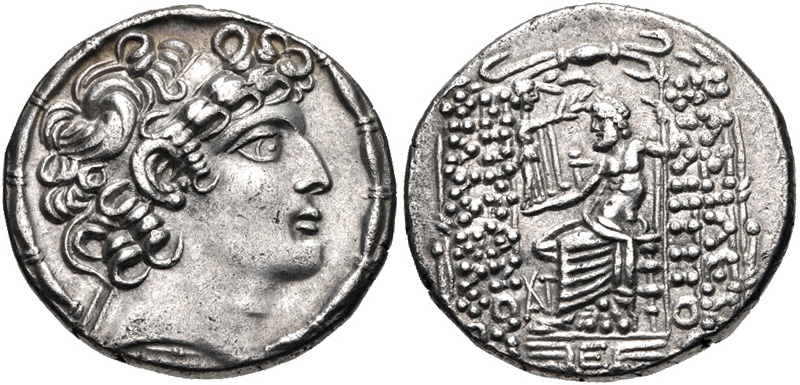
Silver tetradrachm copying the coinage of the Seleucid king Philip Philadelphus (98-83 BC), dated year 5 of the Julian era of Antioch (45-44 BC).
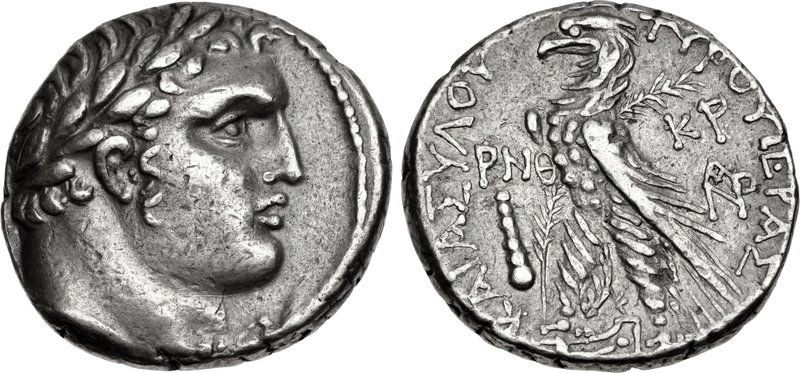
Silver tetradrachm (shekel) of Tyre, dated civic year 159 (AD 33-34). Head of Heracles - Melkart / Eagle.
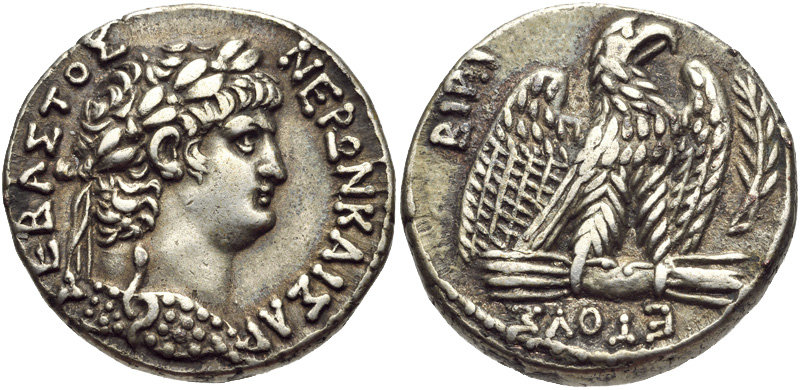
Silver tetradrachm of Nero, dated Julian year 112 of Antioch and regnal year 10 (AD 63-64).
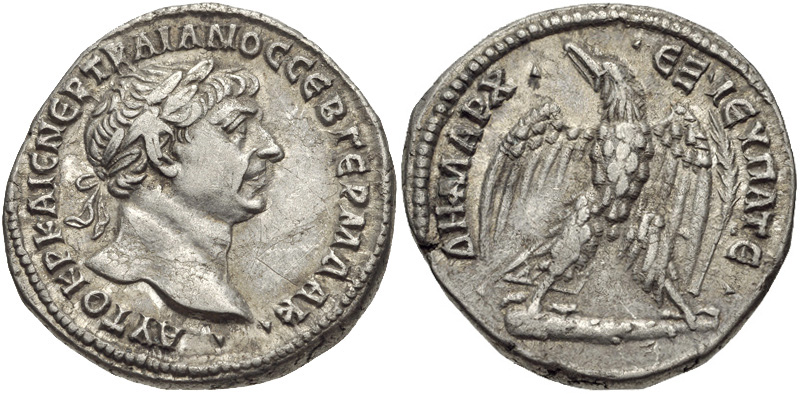
Silver tetradrachm of Trajan, dated by the 15th renewal of his tribunician power, AD 110-111.
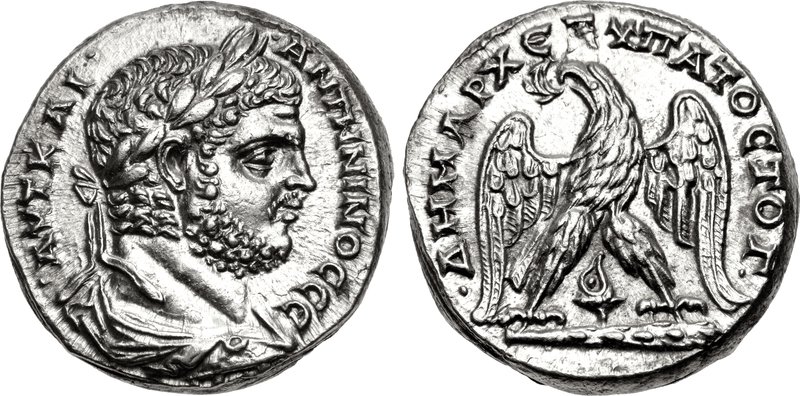
Base silver tetradrachm of Caracalla, dated by his third consulship, AD 208-212. The murex shell between the eagle’s legs is a symbol of the city of Tyre, and this issue is thought to have been struck there.
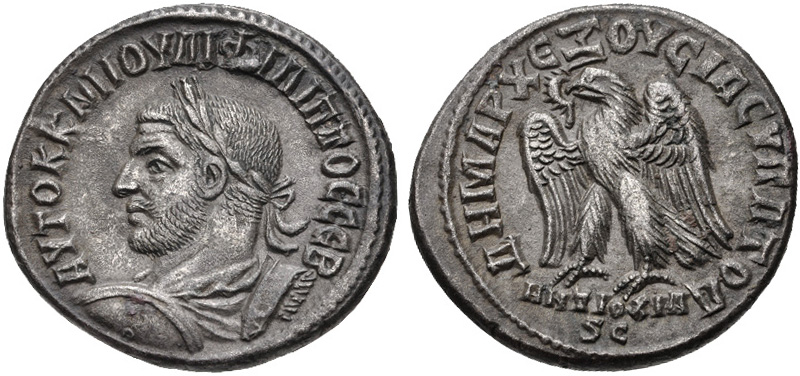
Base silver tetradrachm of Philip, with the mint mark ANTIOXIA under the eagle, and dated to a fourth consulship (there is no other evidence that Philip held a fourth consulship, but the date is presumably AD 249).
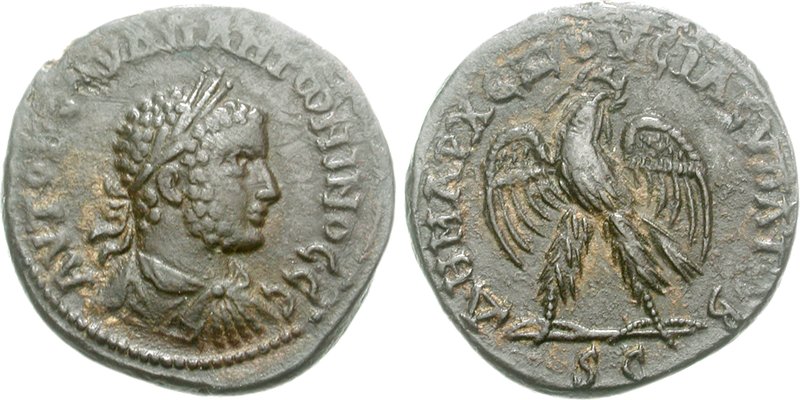
Base silver tetradrachm of the usurper Uranius Antoninus, AD 253-254. He was the last ruler to issue this denomination in Syria.
The SC coinage of Antioch
From the reign of Augustus Antioch issued a coinage with a standardised type: the letters SC in a wreath. The significance of the type is not clear. Normally SC would be understood as senatus consulto, ‘by a decree of the senate’, but the senate had no special authority in Syria, so it is difficult to understand what is meant, if this is the correct interpretation. From Augustus to Nerva (AD 96-98) the inscriptions are in Latin, but under Trajan they switch to Greek (apart from the letters SC). The SC coinage circulated widely in the Near East, but not in other regions. In the third century the letters SC were transferred to the civic bronze coinage of Antioch (and to the silver tetradrachms), but small denominations were still produced with the SC in a wreath down to the reign of Philip (AD 244-249).
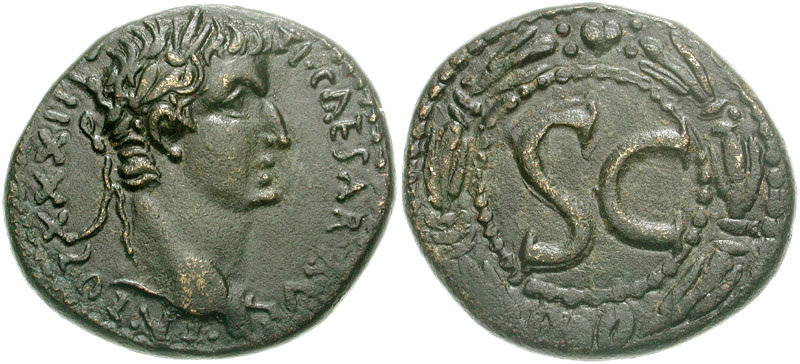
SC bronze of Tiberius (AD 14-37), dated by his 23rd renewal of tribunician power, AD 31-32.
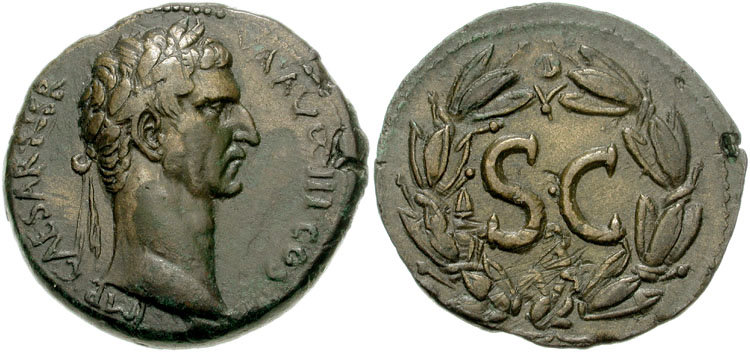
SC bronze of Nerva (AD 96-98), dated by his third consulship, AD 97.
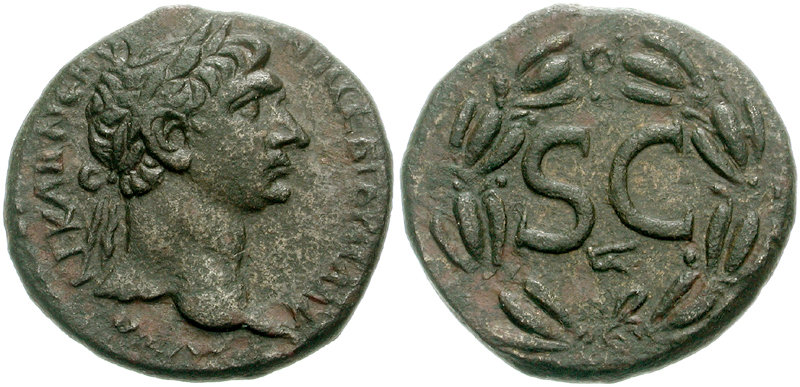
SC bronze of Trajan (AD 98-117).
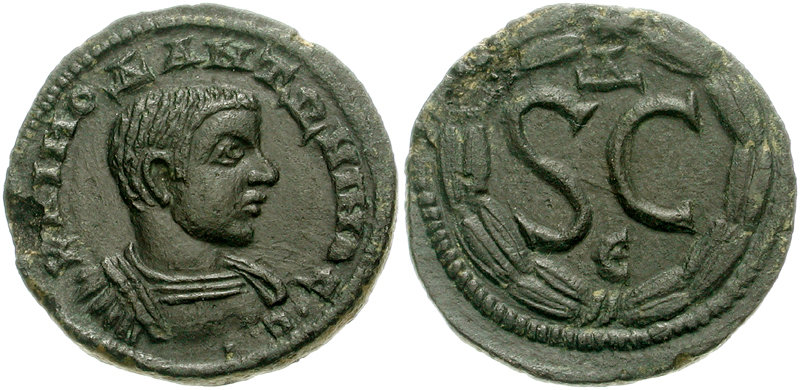
SC bronze of Diadumenian, son of the emperor Macrinus (AD 217-218).
Other non-civic bronze coinage
A series of coins were issued in Judaea without portraits, probably in deference to Jewish mosaic law forbidding 'graven images'. These generally followed the tradition of the earlier Hasmonaean and Herodian kings. After the fall of Jerusalem following the First Jewish War in AD 70, a series of coins with imperial portraits were issued celebrating the Roman victory.
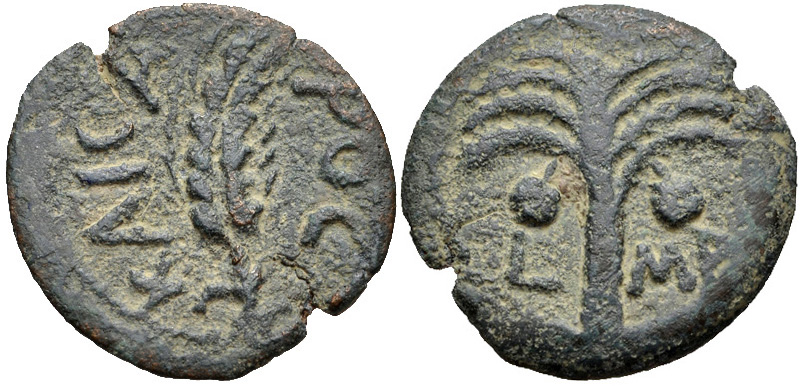
Judaea, under Augustus, regnal year 41 (AD 11, when Marcus Ambibulus was prefect). Ear of corn / palm.
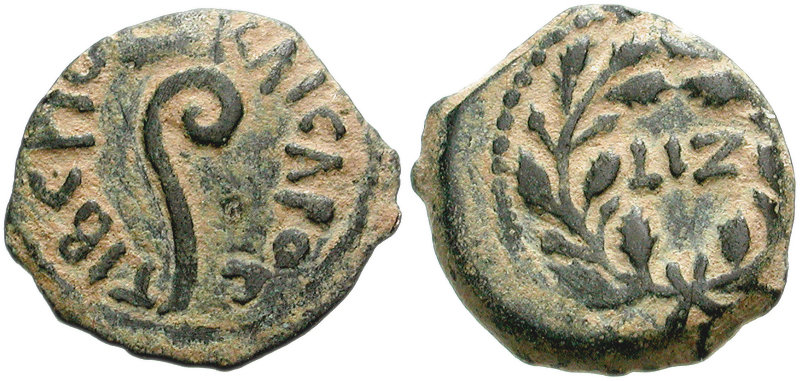
Judaea, under Tiberius, regnal year 17 (AD 30, when Pontius Pilate was prefect). Lituus (Roman priest’s wand) / date in wreath.
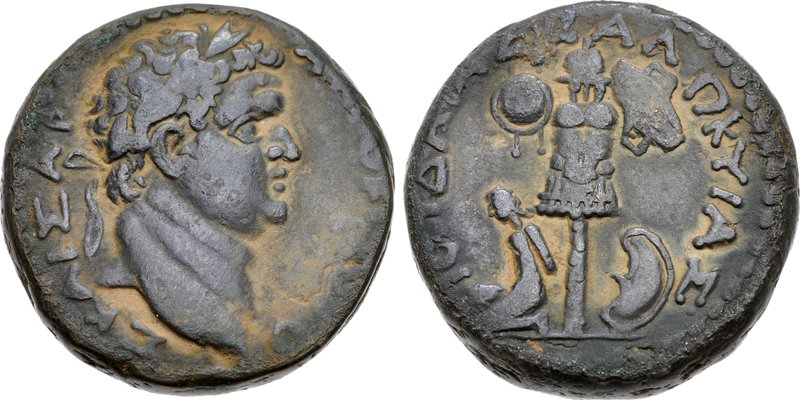
Judaea capta coin of Titus, as Caesar, AD 69-79, possibly struck at Caesarea. Captive and shield either side of military trophy.
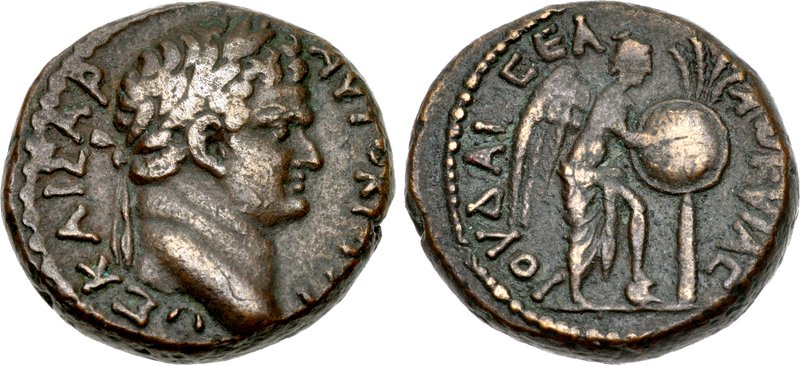
Judaea capta coin of Titus, as Caesar, AD 69-79, possibly struck at Caesarea. Victory inscribing shield attached to palm.
The Koinon of Syria
In some provinces and regions issues were produced for koina, regional associations of the imperial cult. Only one issue is known for the Syrian koinon. The koina were important routes of communication between the cities that came together for provincial assemblies of the cult, and the emperors.
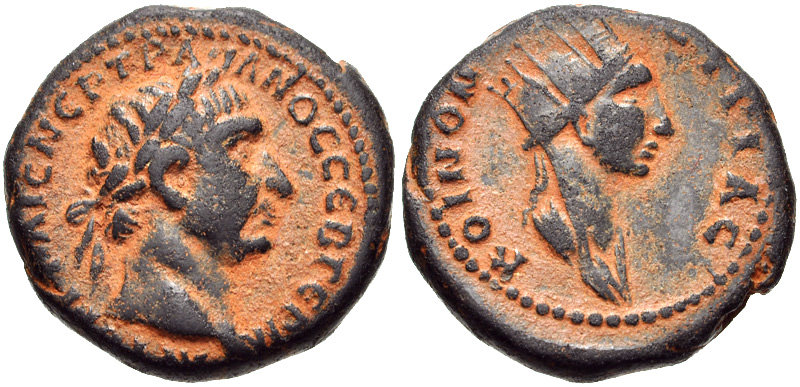
Issue for the koinon of Syria, struck under Trajan, c. AD 98-99. Bust of a city Tyche (probably Antioch, the chief city of the provincial imperial cult in Syria and the city were the provincial assembly took place).
Civic coinage
In contrast to the limited number of cities producing silver coinage, many more cities issued their own bronze coinage. Below is only a sample of the diversity of civic coinage in the Near East.
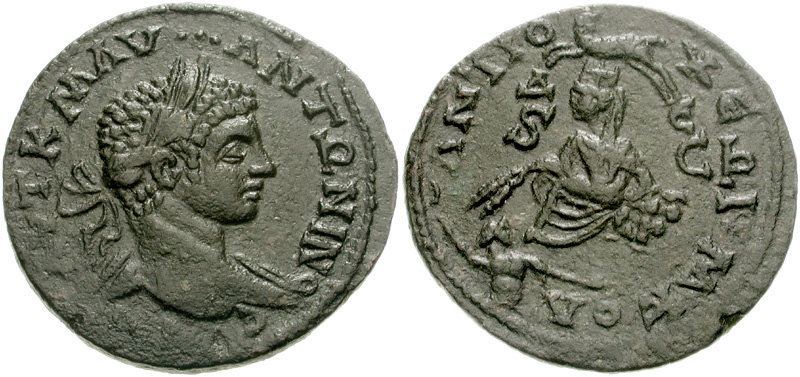
Antioch, civic bronze of Elagabalus (AD 218-222). The reverse type depicts the Tyche of Antioch, the river Orontes swimming at her feet, and what appears to be an astrological symbol (Aries) above. Throughout the first and second centuries AD most civic bronzes of Antioch had been small denominations without imperial portraits; imperial portraits were generally reserved for the SC coinage (which lacks any reference to an issuing city). However, from Elagabalus to Valerian (AD 253-260) a plentiful civic bronze coinage was produced at Antioch with imperial portraits.
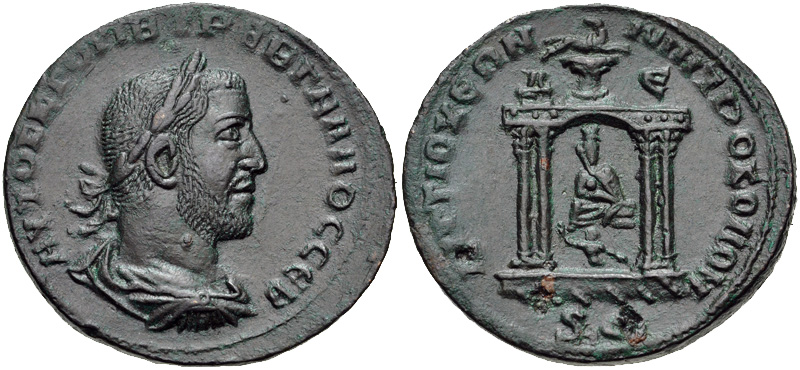
Antioch, civic bronze of Trebonianus Gallus (AD 251-253). The Tyche of Antioch in a portable shrine (note the carry-bars on the base of the shrine).
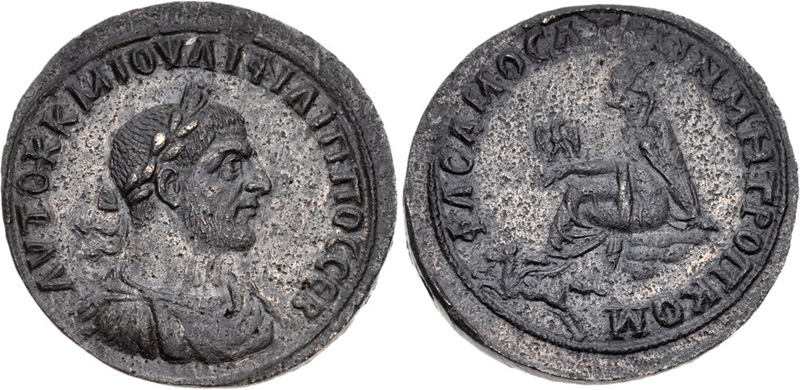
Samosata, Philip I (AD 244-249). The Tyche of Samosata, who appears here as a variation on the Tyche of Antioch, with Pegasus rather than a river god.
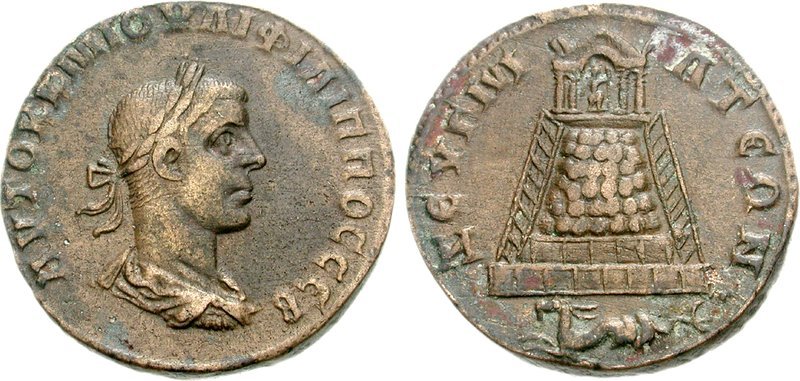
Zeugma, Philip II as Augustus, AD 246-249. A temple on a prominent hill. Note the astrological symbol Capricorn (a symbol of the legion stationed there?).
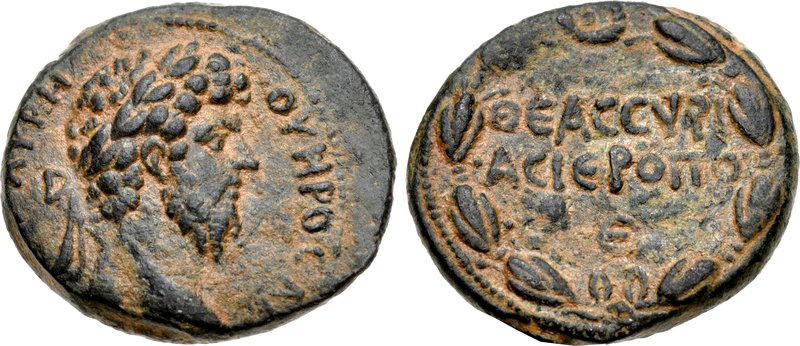
Hierapolis, Lucius Verus (AD 161-169). Ethnic in wreath, copying the SC bronzes of Antioch.
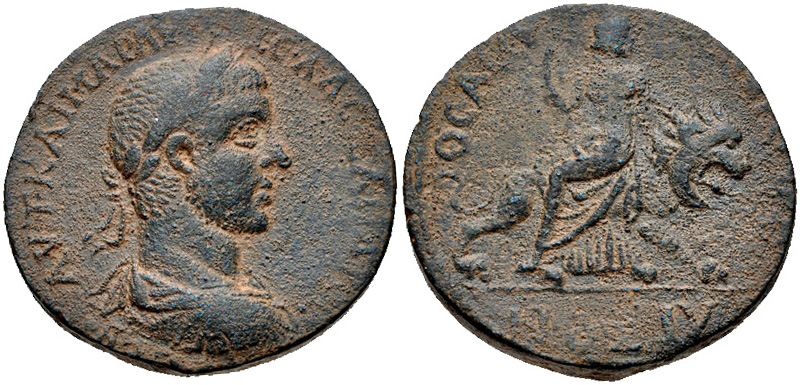
Hierapolis, Severus Alexander (AD 222-235). The Syrian goddess, Atargatis, riding on a lion.
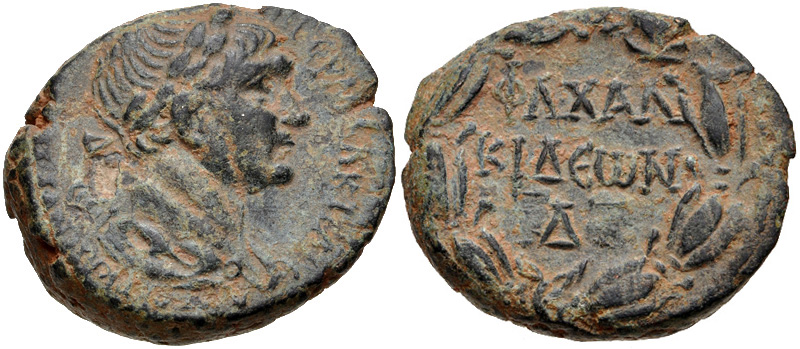
Chalcis ad Belum, Trajan (AD 98-117). Ethnic in wreath.
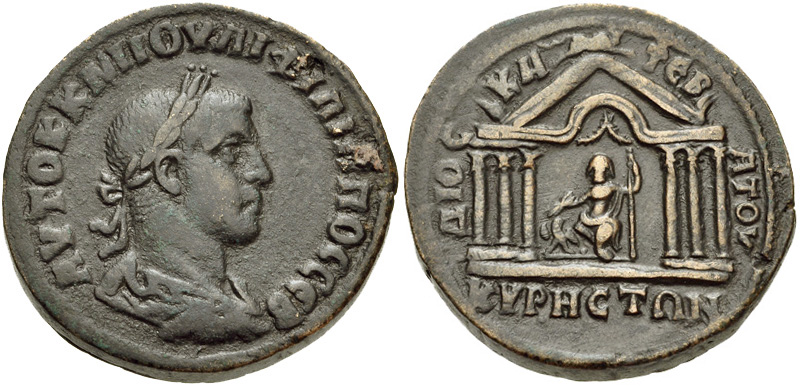
Cyrrhus, Philip II as Augustus (AD 246-249). Temple with figure of Zeus, astrological figure (Taurus) above.
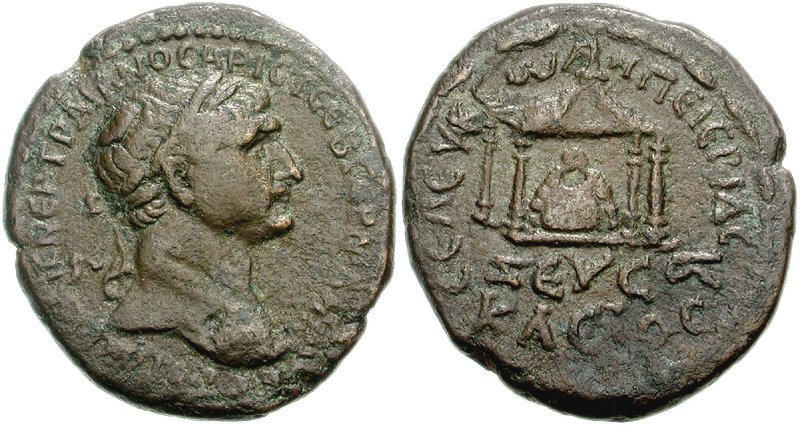
Seleucia Pieria, Trajan (AD 98-117). Shrine containing mountain image (‘baetyl’), labelled ‘Zeus Kasios’, the Zeus of Mount Casius, the large mountain to the south of the city.
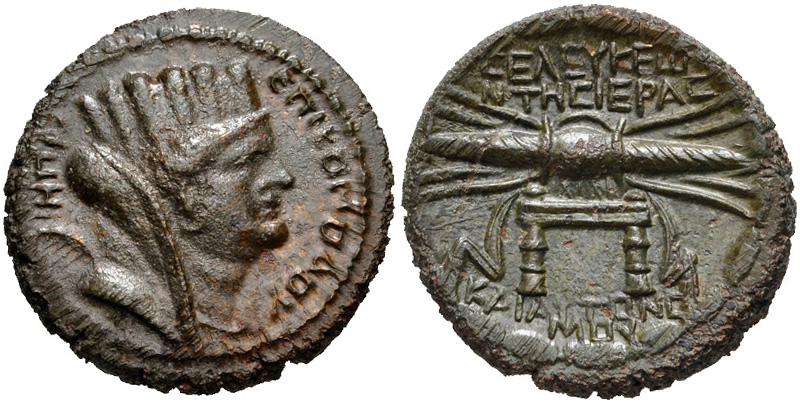
Seleucia Pieria, ‘pseudo-autonomous’ coin dated year 188 of the city (AD 79-80), therefore issued during the reign of Titus (AD 79-81). Head of city tyche / thunderbolt of Zeus Keraunios (‘thunderbolt Zeus’) on throne.
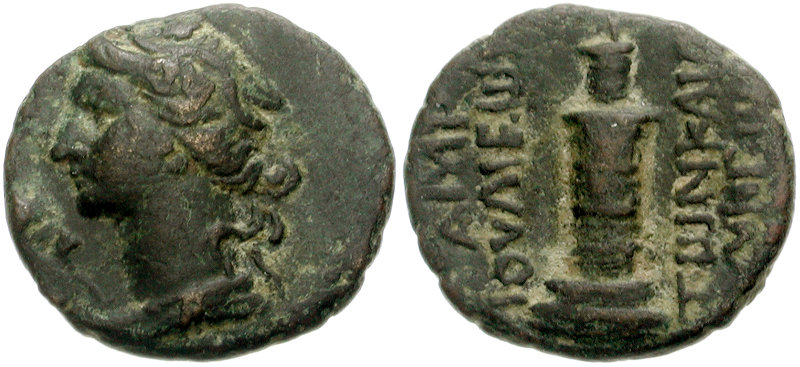
Laodicea, ‘pseudo-autonomous’ issue of the second century AD. Head of Dionysus / the lighthouse of Laodicea.
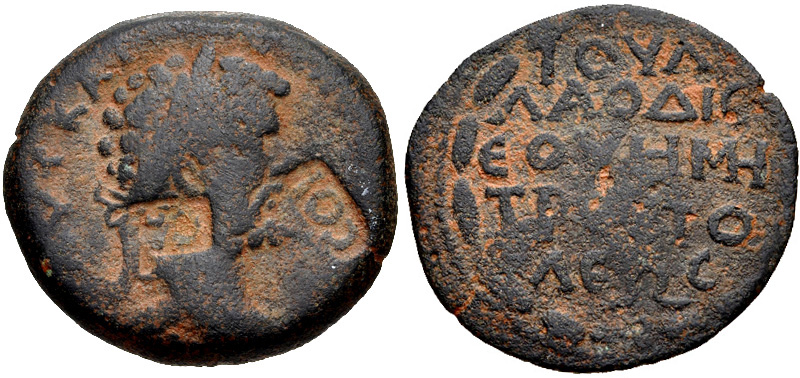
Laodicea, Septimius Severus (AD 193-211). This coin was issued after Antioch’s disgrace for having supported Pescennius Niger. Laodicea has been granted the title metropolis (traditionally Antioch’s title) but is not yet a colonia. Note however a countermark on the obverse of the coin, reading COL.
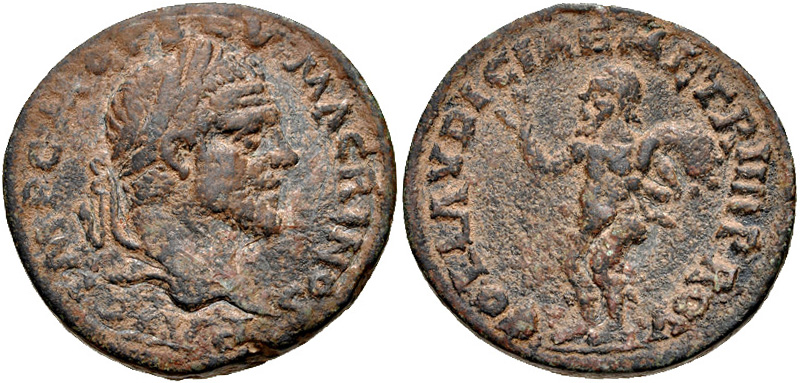
Laodicea, Macrinus (AD 217-218). Figure of the satyr Marsyas (the image is found on coins of coloniae in the Near east during the third century). The inscription refers to Laodicea as the centre of the provincial imperial cult (which was traditionally Antioch’s role): COL LAVDICIAE METR IIII PROV, ‘of the colonia of Laodicea, metropolis of the four provinciae’ (the provincial imperial cult of Syria was divided into four ‘provinces’).
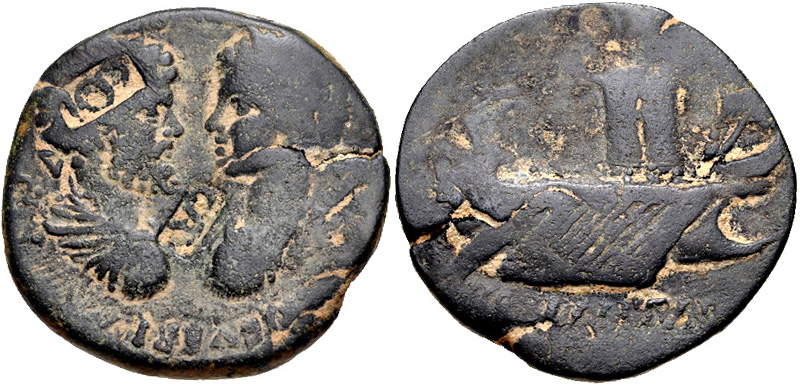
Laodicea, Septimius Severus with Caracalla. A ship carrying a gift of grain sailing past the city’s lighthouse.
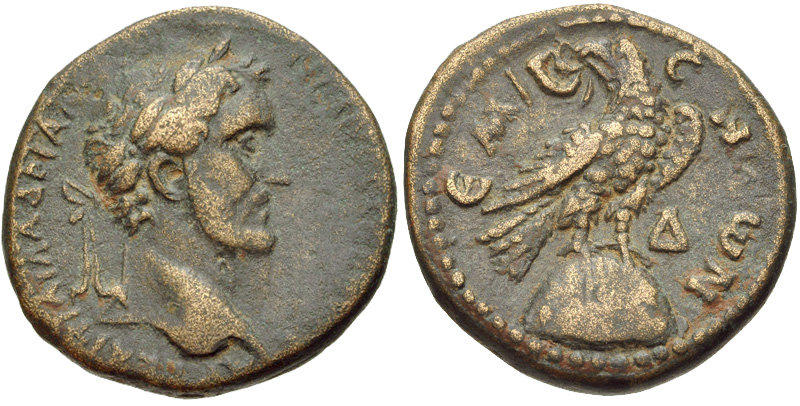
Emesa, Antoninus Pius (AD 138-161). Eagle perched on cult stone (‘baetyl’).
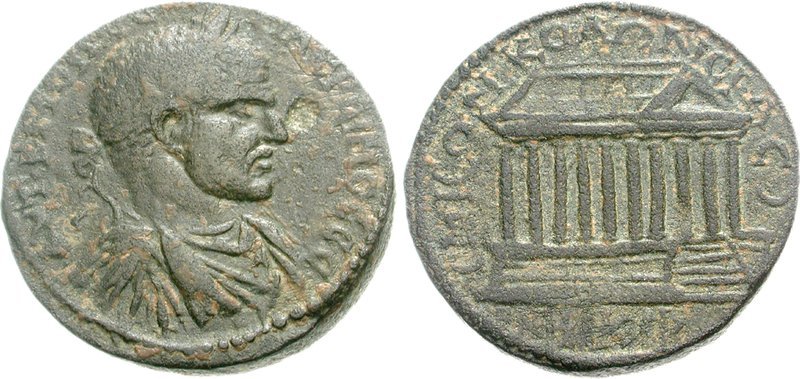
Emesa, Macrinus (AD 217-218). Temple of Elagabal.
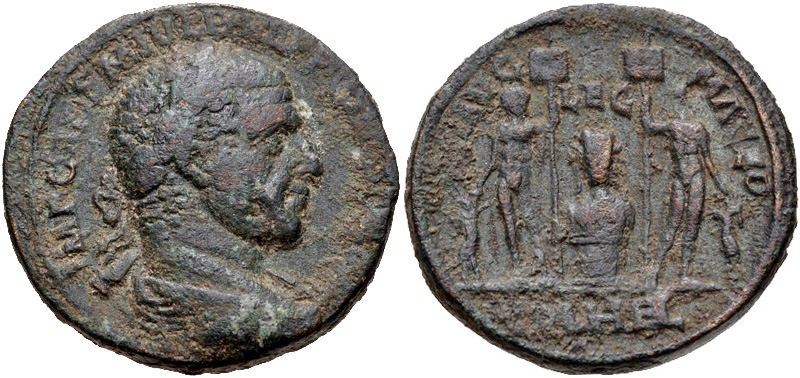
Heliopolis, Philip I (AD 244-249). Bust of the Tyche of Heliopolis (with sun’s rays emanating from her head) flanked by male figures holding animals and vexilla.
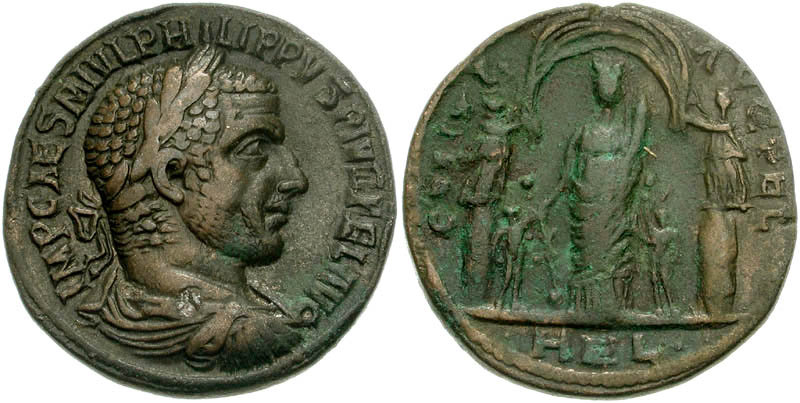
Heliopolis, Philip I (AD 244-249). Tyche of Heliopolis, with two victories on pedestals holding a veil over her; either side, two small male figures holding uncertain objects.
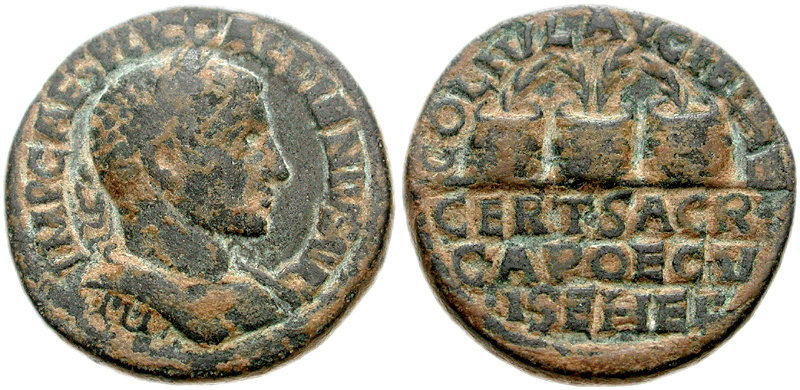
Heliopolis, Gallienus (AD 253-268). Three prize crowns containing victors' palm branches. The inscription below refers to ‘Sacred Capitoline Ecumenical Iselastic Heliopolitan Games’, which may be the name of a single festival, but is possibly a reference to more than one festival.
The coins of Heliopolis also depict the temples of the city. For a video about these, see Baalbek.
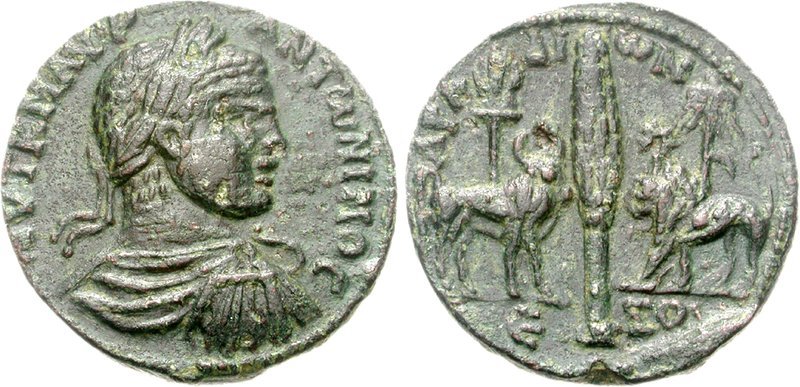
Aradus, Elagabalus (AD 218-222). Cypress tree, flanked by lion and bull, each with a semeion (religious ensign) behind.
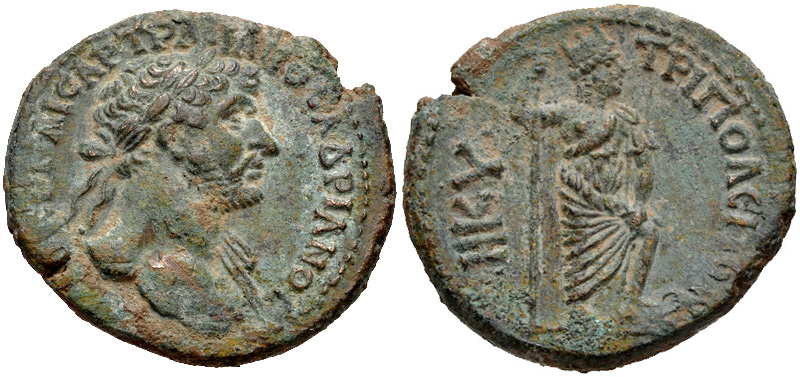
Tripolis, Hadrian (AD 117-138). Phoenician-style standing city Tyche.
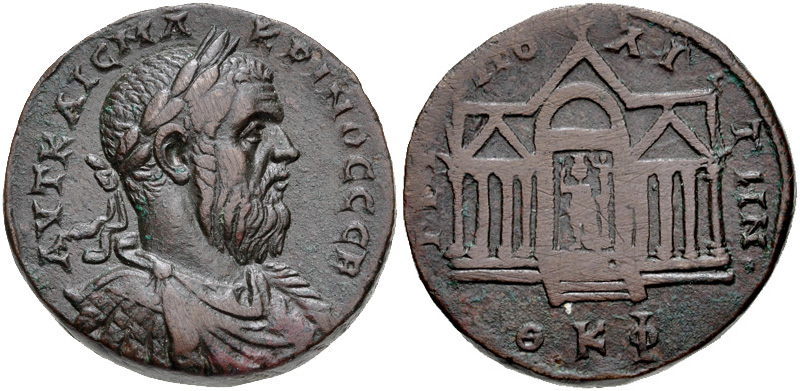
Tripolis, Macrinus (AD 217-218). Temple containing image of city Tyche.
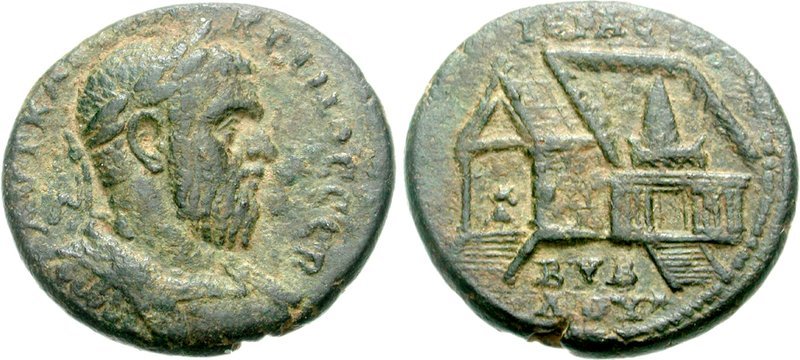
Byblus, Macrinus (AD 217-218). Temple with large conical or pyramidal cult object in colonnaded court.
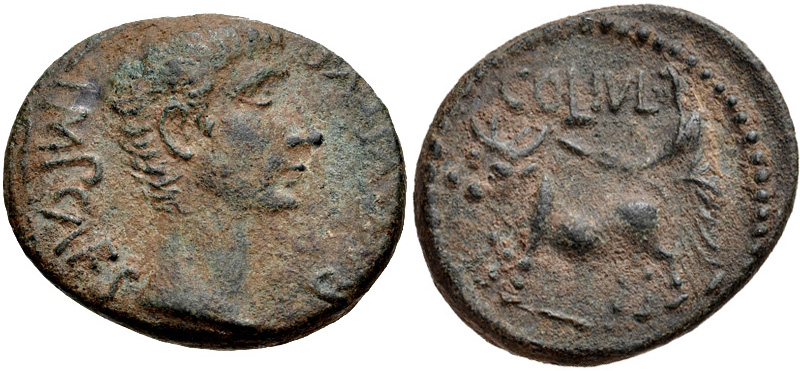
Berytus, Augustus (27 BC – AD 14). Priest ploughing the first furrow to demarcate the boundary of the new colonia. The image may well be symbolic rather than a depiction of an event that really happened.
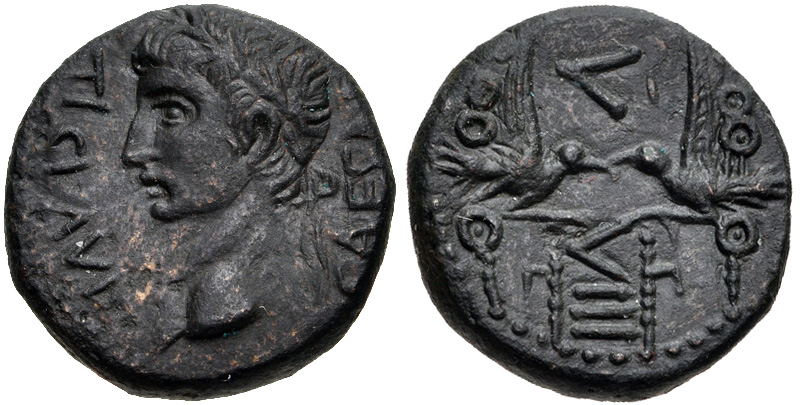
Berytus, Claudius (AD 41-54). Two legionary eagles, with the numbers of the legions (V and VIII) from which the veteran settlers of the colonia came.
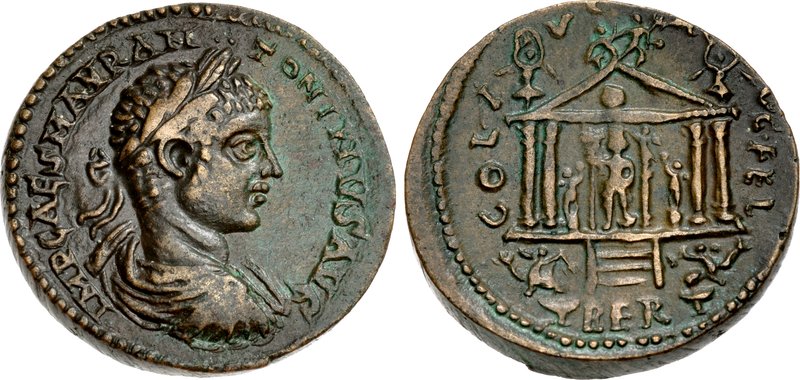
Berytus, Elagabalus (AD 218-222). Temple containing figure of Tyche.
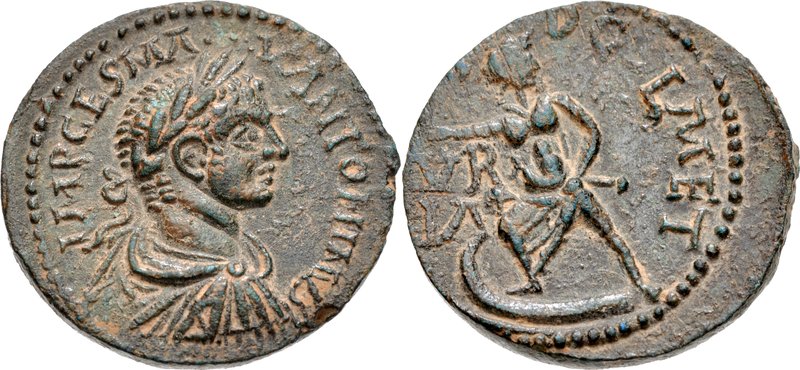
Sidon, Elagabalus (AD 218-222). Phoenician hero Kadmos on ship’s prow.
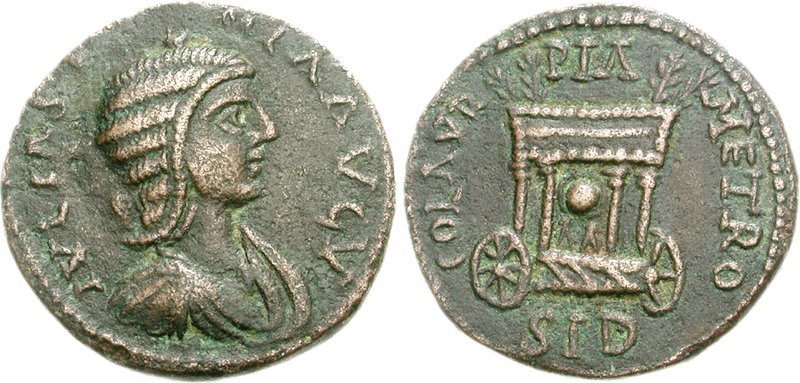
Sidon, Julia Soaemias, mother of Elagabalus. Cult object (spherical stone?) in wheeled portable shrine. When Tyre rebelled against Elagabalus, Sidon remained faithful and was awarded the title Colonia Aurelia. It also gained the title Pia (‘faithful’).
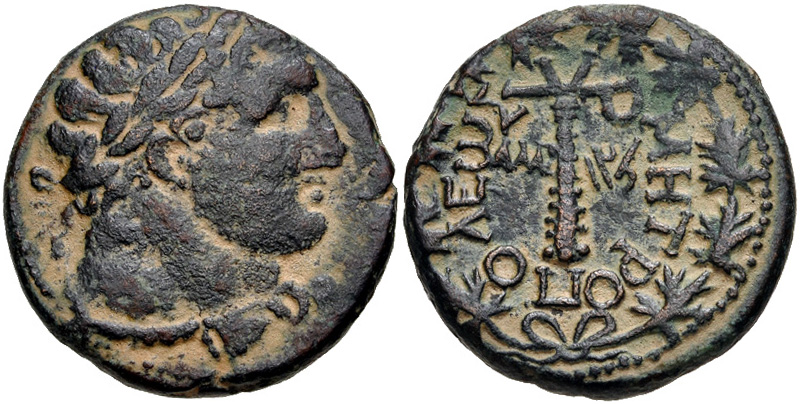
Tyre, ‘pseudo-autonomous’ coin, dated year 241 of the city (AD 115-116, therefore during the reign of Trajan). Head of Heracles (Melkart) / Monogram of Tyre on club. Before Septimius Severus (AD 193-211), all of Tyre’s bronze coinage was without imperial portraits. This is unusual; only a few other cities did not place the emperor’s portrait on coins, and probably marks out Tyre as having special privilege as an autonomous city.
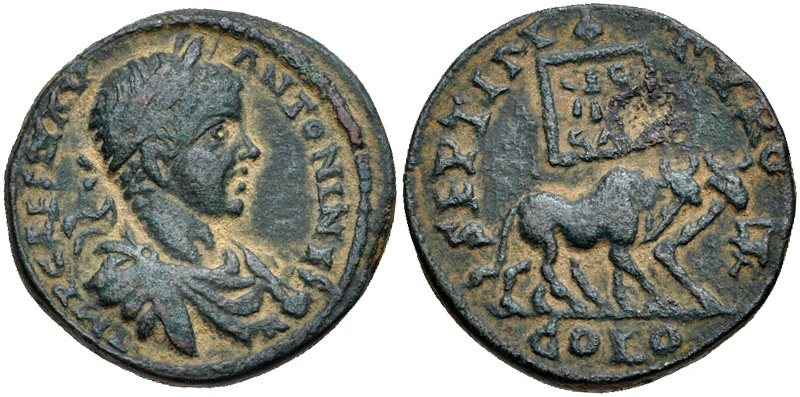
Tyre, Elagabalus (AD 218-222). This coin was produced before the city was disgraced, when the city still had the title colonia. Ironically the vexillum behind the two bovines reads LEG III GAL. A detachment of the legio III Gallica in the city rebelled against Elagabalus, who punished the city by stripping it of colonial and metropolitan status.
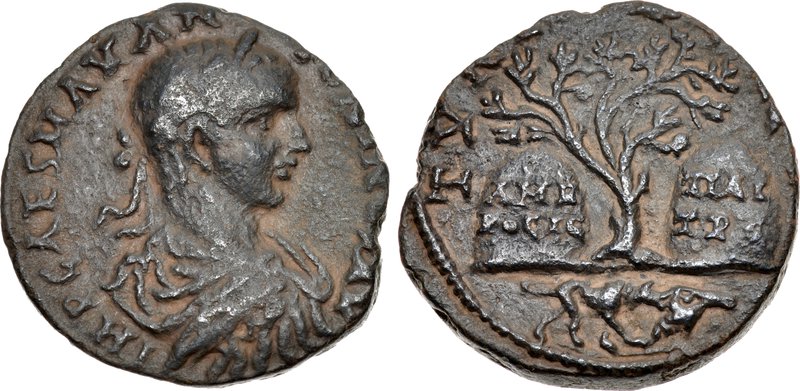
Tyre, Elagabalus (AD 218-222). The Ambrosial Rocks, the legendary origin of Tyre as two rocks floating in the sea. Beneath is a reference to the discovery of sea purple: Heracles’ dog found a murex on the beach and chewed it, producing a purple froth. The inscription reads simply TYRIORVM (‘of the Tyrians’) and lacks the titles of metropolis and colonia.
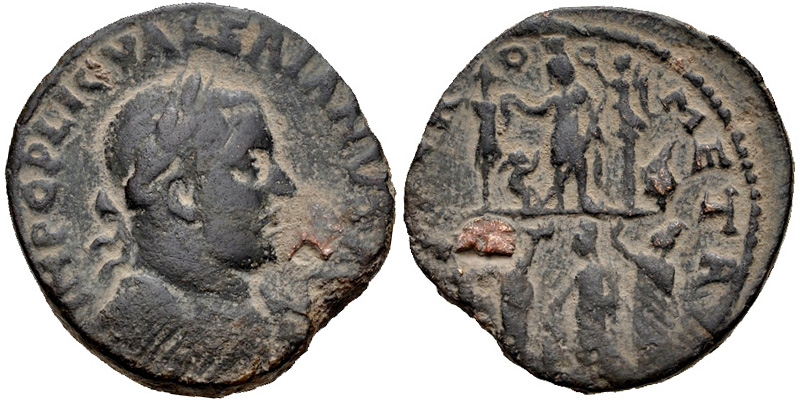
Tyre, Valerian (AD 253-260). This is probably a reference to the provincial imperial cult. Above, the Tyche of Tyre; below, four more tychai probably representing the four divisions of the provincial imperial cult (see the coins of Laodicea, above). After Elagabalus the titles of colonia and metropolis were restored.
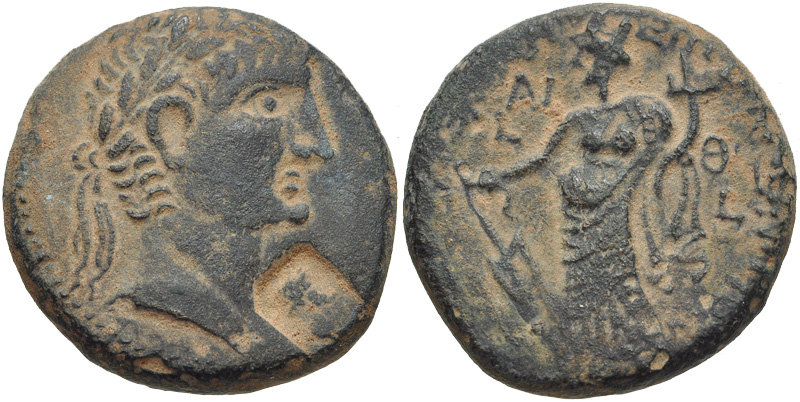
Ptolemais, Claudius (AD 41-54). City Tyche. This coin, with its Greek inscriptions, was issued before the foundation of the colonia under Claudius. Note the countermark on the obverse, which contains a male bust (barely visible on this specimen).
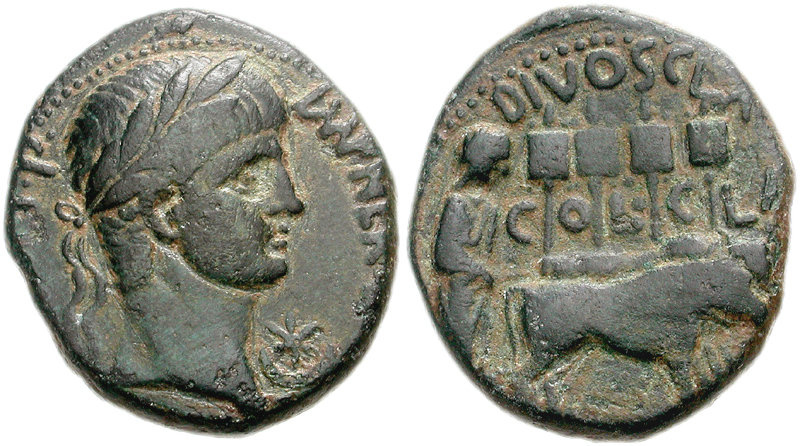
Ptolemais, Nero (AD 54-68). Foundation scene. The inscription includes an abbreviation for the name of the colonia and DIVOS CLA, a reference to Claudius’ cult. As founder he no doubt had a cult in this capacity as well as the official cult established from Rome.
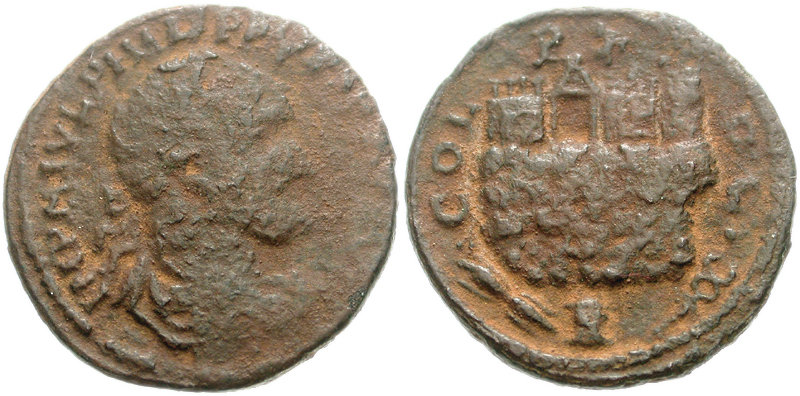
Ptolemais, Philip I (AD 244-249). The acropolis of Ptolemais, with walls, a gate and tower; below, altar and thunderbolt.
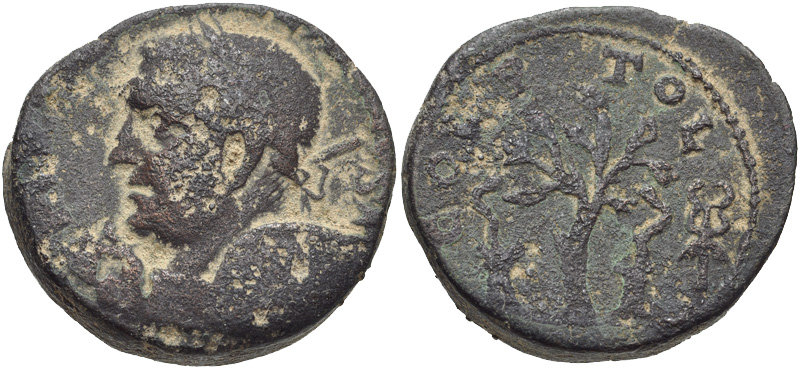
Ptolemais, Valerian (AD 253-260). Tree flanked by two altars from which a serpent rises; caduceus (the wand of Hermes) to left.
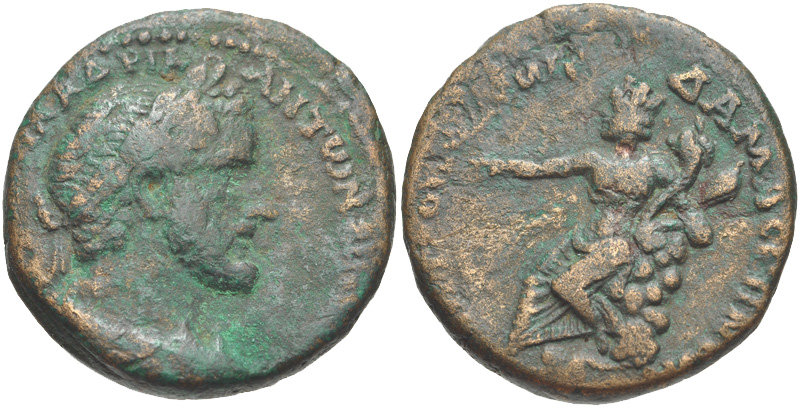
Damascus, Antoninus Pius (AD 138-161). The Tyche of Damascus.
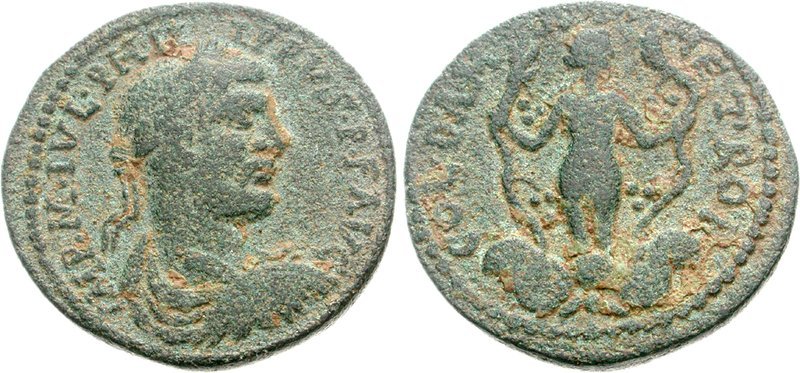
Damascus, Philip I (AD 244-249). Naked female figure clasping vine tendrils. This is probably a representation of the nymph Ambrosia, who turned herself into a vine plant when helping Dionysus fight Lycurgus. The battle was supposed to have taken place in this region (although an alternative tradition placed it in Thrace).
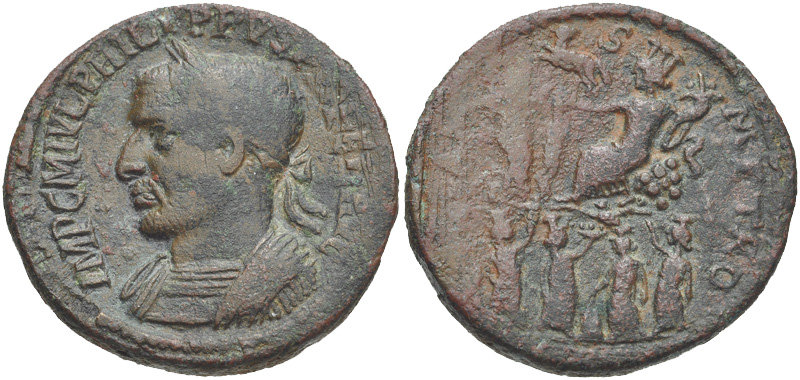
Damascus, Philip I. The Tyche of Damascus; below, four other tychai, probably representing the divisions of the provincial imperial cult (note its similarity to the Tyre coin above).
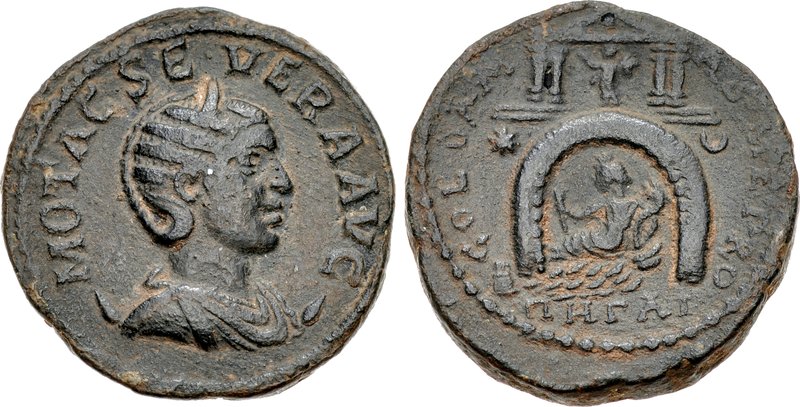
Damascus, Otacilia Severa, wife of Philip (AD 244-249). Water emerging from a grotto, with river god reclining in it; above, temple. The inscriptions are in Latin (appropriate for a colonia), but beneath the spring is the Greek word pegai (‘springs’). This is almost certainly a representation of the temple at the source of the Barada river which flows through Damascus.
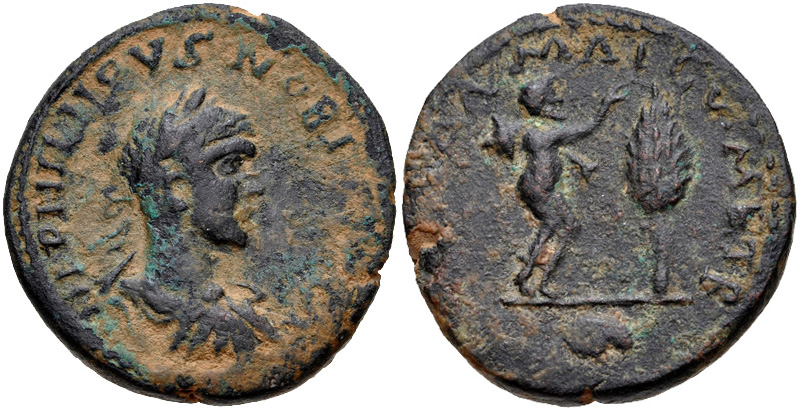
Damascus, Philip II (AD 246-249). The satyr Marsyas and a cypress tree (probably a cult object). Below, a ram’s head (a symbol of the city).
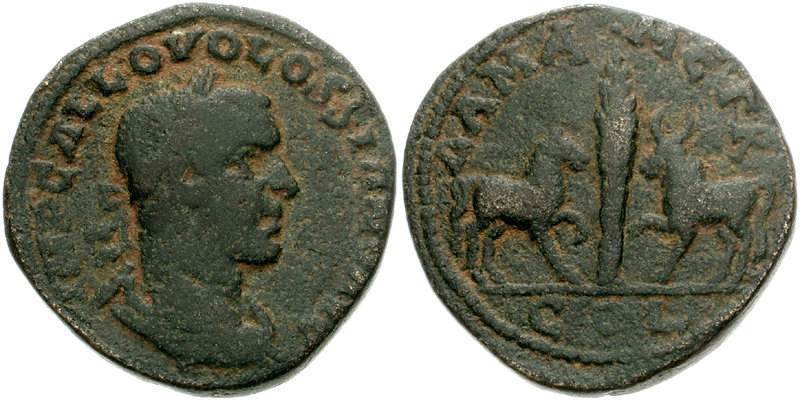
Damascus, Volusian (AD 251-253). Cypress tree flanked by a horse and a bull (note the similarity to the coin of Aradus).
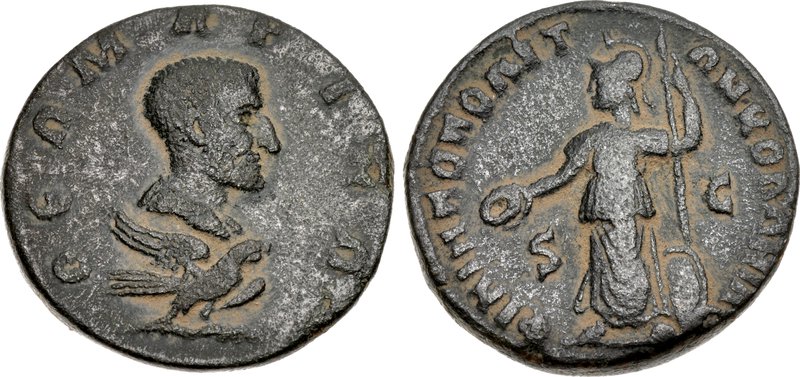
Philippopolis, Divus Julius Marinus, father of the emperor Philip. This coinage was probably struck at Antioch for use in Philippopolis, c. AD 246-249. A cult of Philip’s father seems to have existed at Philippopolis, the city thought to be Philip’s birthplace; this is the only known civic coinage in the name of the emperor’s father.
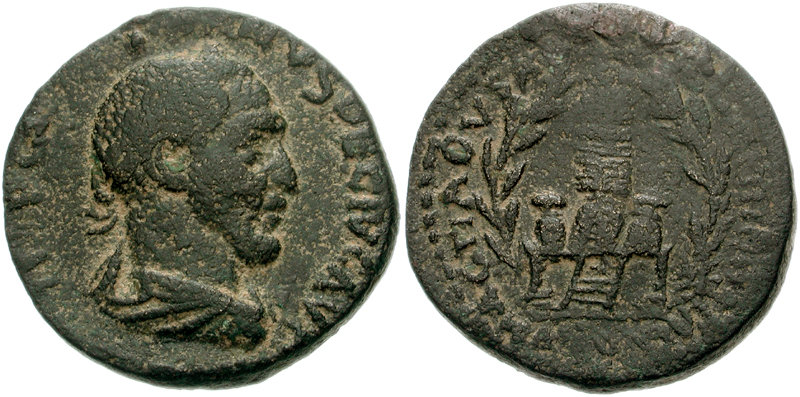
Bostra, Trajan Decius (AD 249-251). Raised shrine (motab) with cult images.
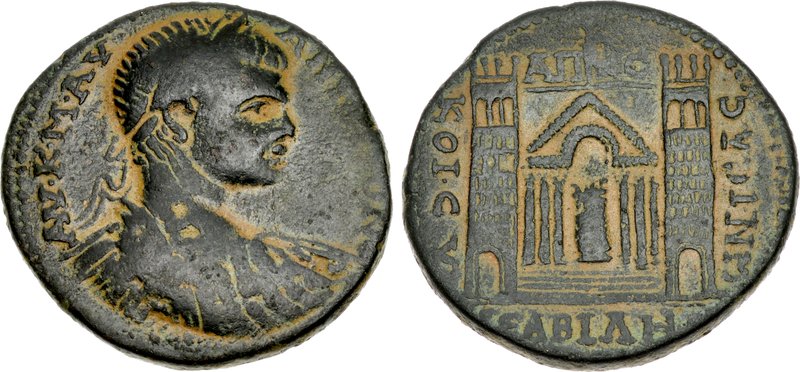
Abila, Elagabalus (AD 218-222), dated civic year 281 (AD 218). Temple with flanking towers.
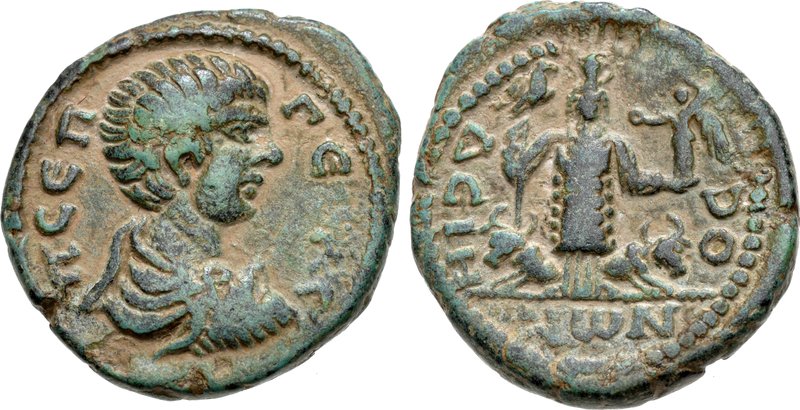
Dium, Geta, son of Septimius Severus, as Caesar, AD 198-209. Deity resembling Jupiter Heliopolitanus, holding a victory and eagle tipped sceptre, flanked by two bulls.
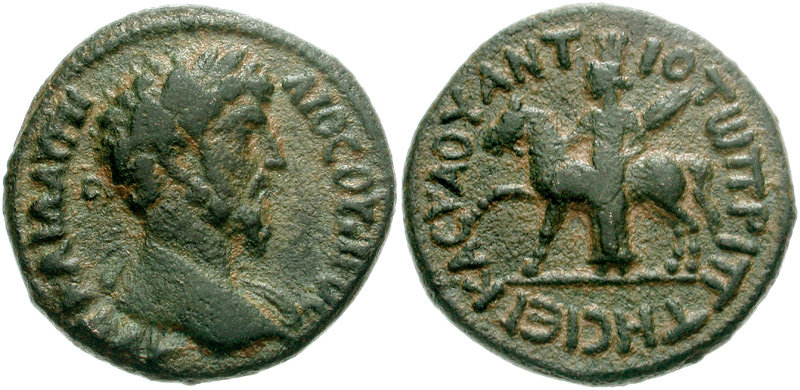
Hippus (or Antioch ad Hippum), Lucius Verus (AD 161-169). Tyche with ‘bouquet’, holding horse by the bridle.
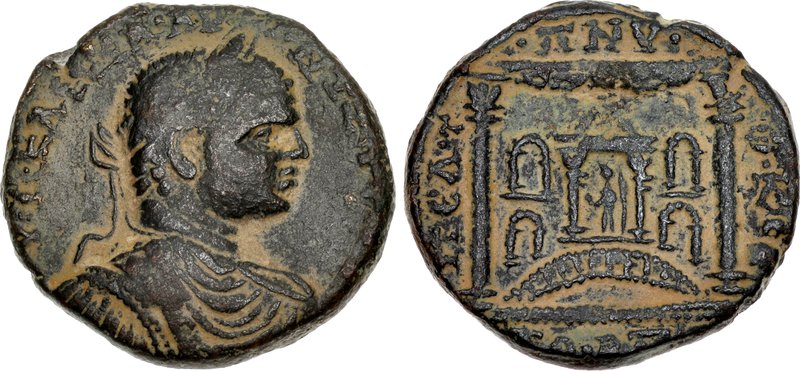
Pella, Elagabalus (AD 218-222). Unidentified building with columns and niches, perhaps a nymphaeum. Dated civic year 282 (AD 218-219).
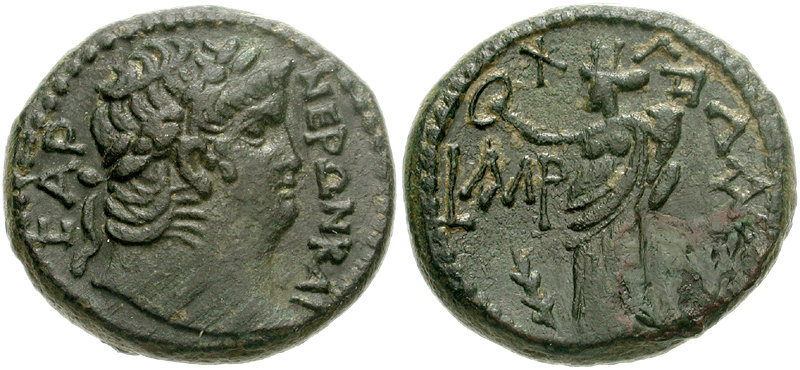
Gadara, Nero (AD 54-68). Tyche of Gadara.
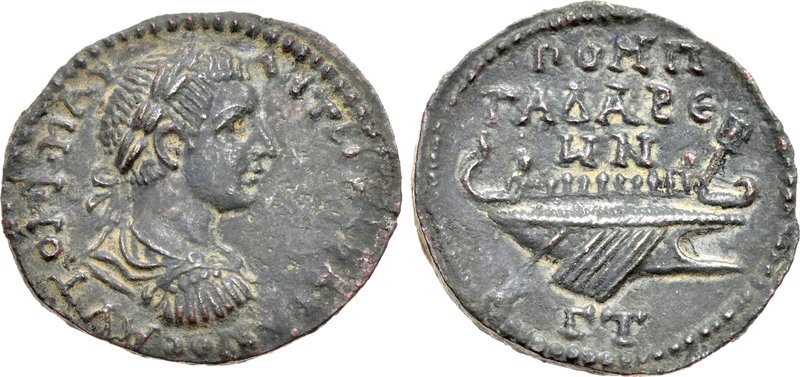
Gadara, Gordian III (AD 238-244), dated civic year 303 (AD 239-240). Galley. This perhaps refers to a naumachia (mock sea battle) performed on the nearby Sea of Galilee. The city’s titles include ‘Pompeia’, a reference to its re-foundation by Pompey.
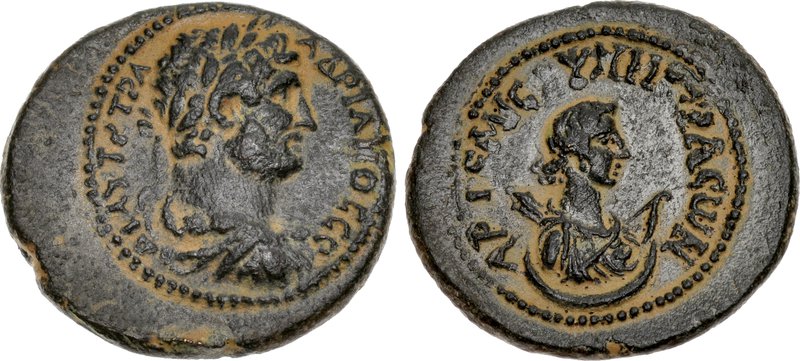
Gerasa, Hadrian (AD 117-138). Bust of Artemis on crescent.
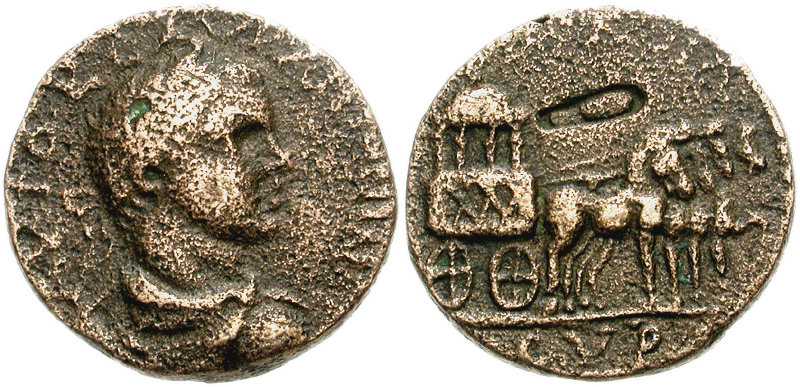
Philadelphia, Elagabalus (AD 218-222). Portable shrine drawn by horses.
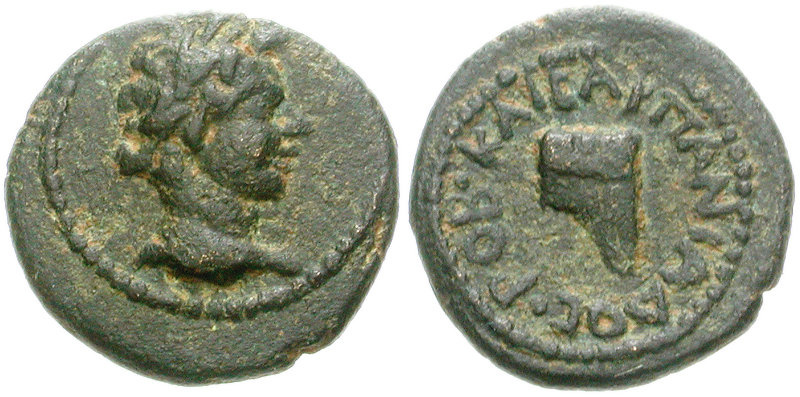
Paneas, ‘pseudo-autonomous’ coin, dated civic year 172 (AD 169-170, under Marcus Aurelius, AD 161-180). Pan / Pan pipes (syrinx).
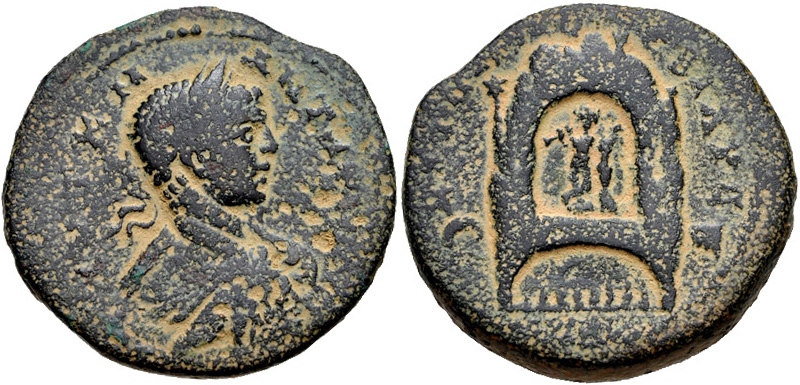
Paneas, Elagabalus (AD 218-222). Sanctuary of Pan: rock face with niche containing image of Pan playing flute; grotto beneath.
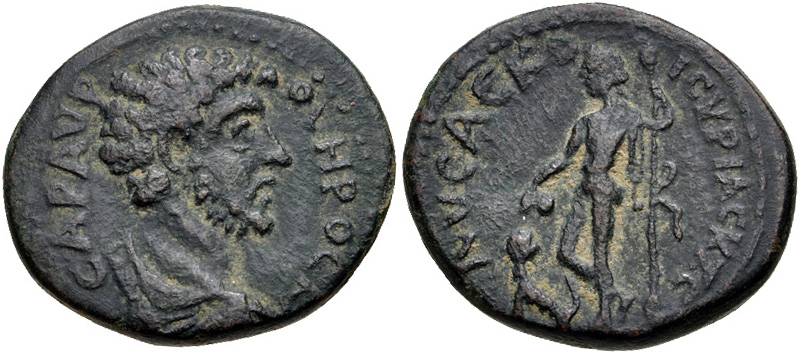
Nysa Scythopolis, Lucius Verus (AD 161-169). Dionysus. Nysa was the nymph who nursed the infant Dionysus.
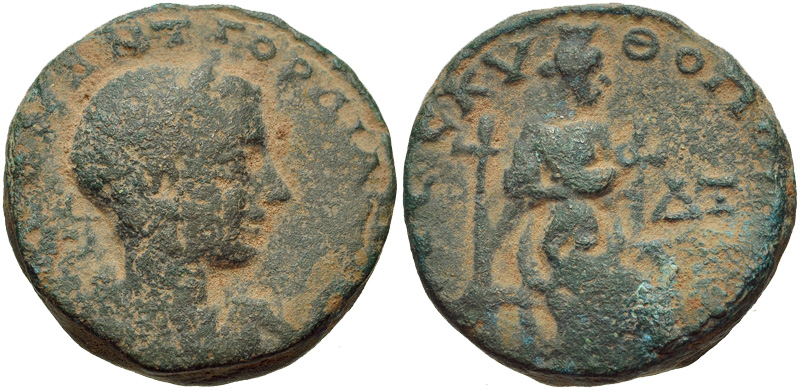
Nysa Scythopolis, Gordian III (AD 238-244). The nymph Nysa cradling the infant Dionysus.
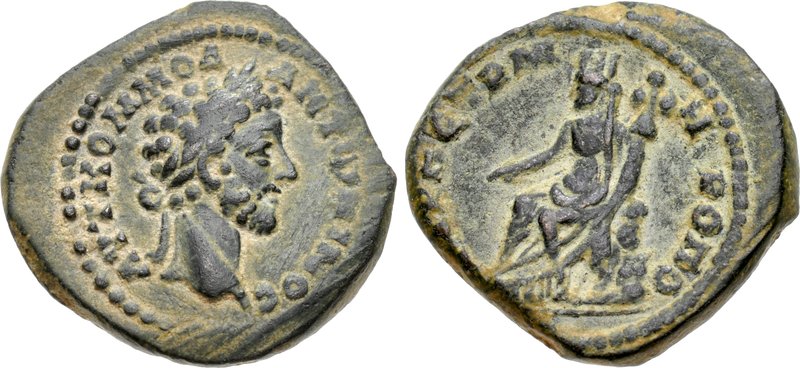
Petra, Commodus (AD 177-192). Tyche of Petra, holding a military trophy over her shoulder.
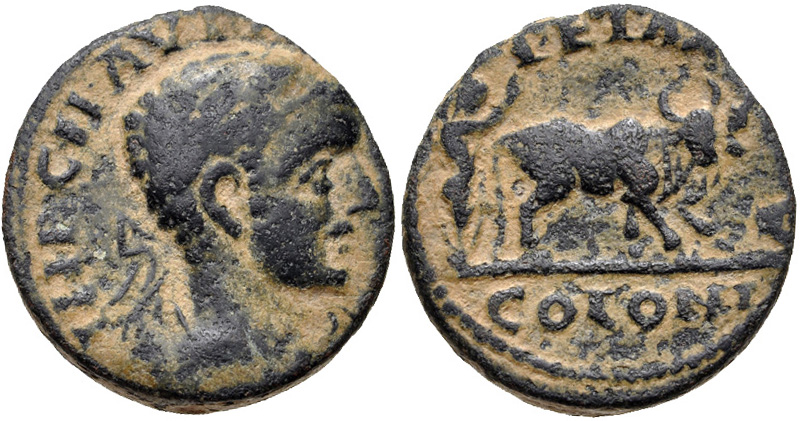
Petra, Elagabalus (AD 218-222). Foundation scene. This, the last civic issue of Petra, records the city’s status as a colonia.
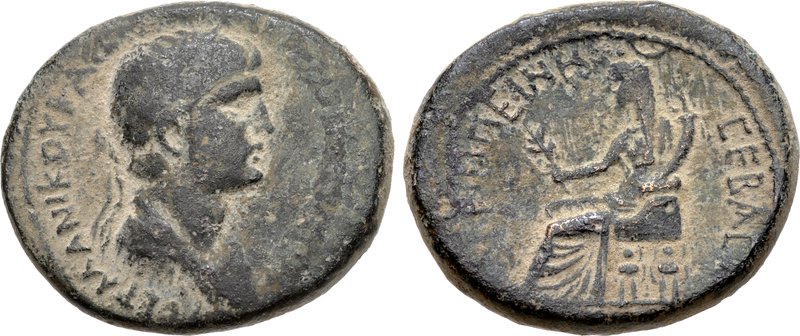
Caesarea, Nero (AD 54-68). His mother Agrippina seated on a throne, holding a branch and cornucopia.
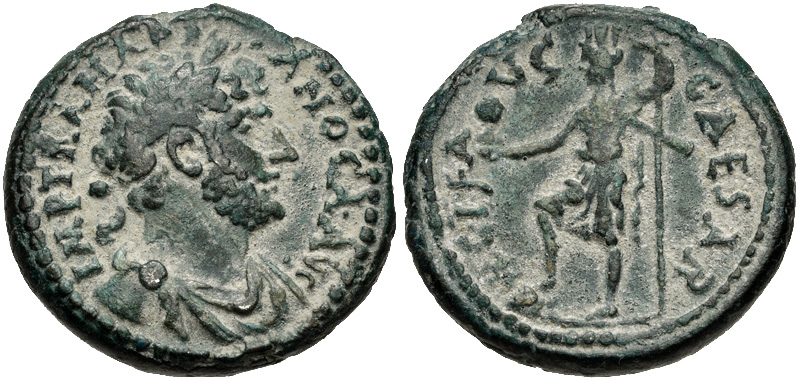
Caesarea, Hadrian (AD 117-138). The Tyche of Caesarea.
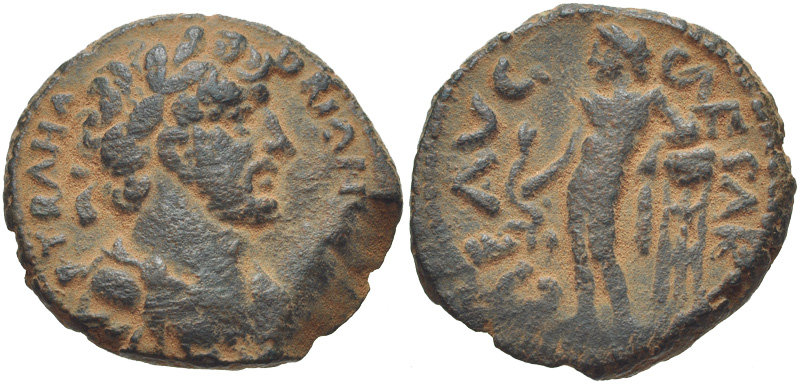
Caesarea, Hadrian. Apollo leaning on tripod.
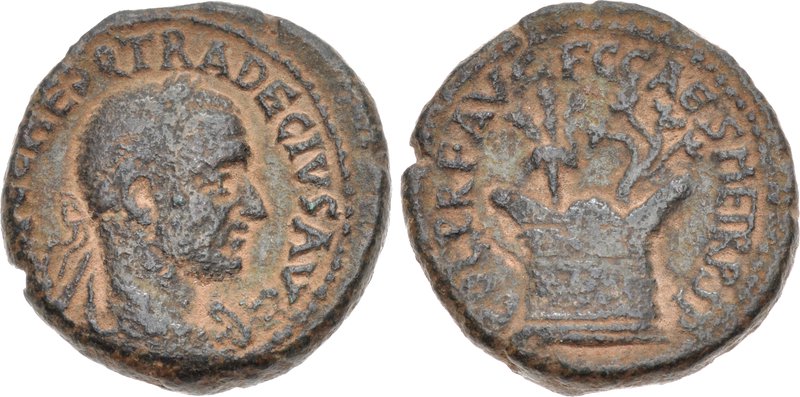
Caesarea, Trajan Decius (AD 249-251). Altar; above, palm and olive (?) tree. Possibly a reference to Apollo, thought to have been born beneath a palm and olive.
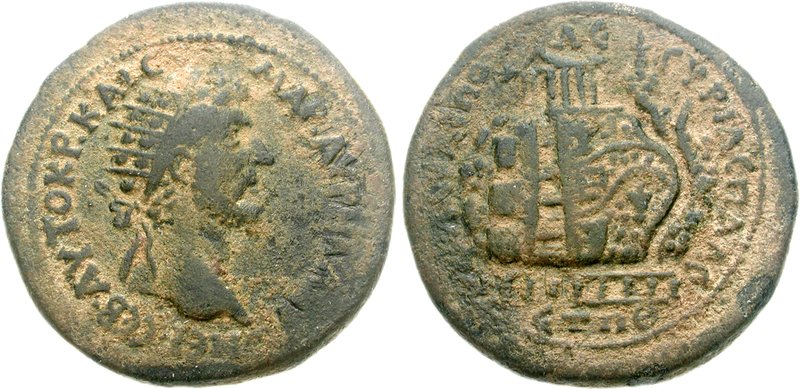
Neapolis, Marcus Aurelius (AD 161-180), dated civic year 89 (AD 161). Mount Gerizim, with staircase leading to temple.
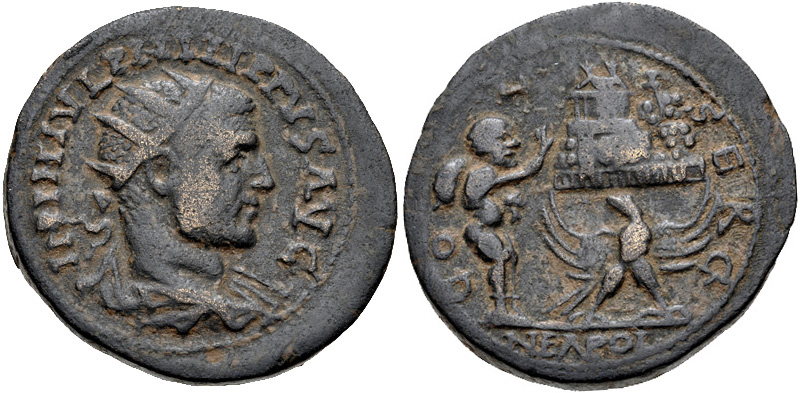
Neapolis, Philip I (AD 244-249). Marsyas; and Mount Gerizim supported by an eagle.
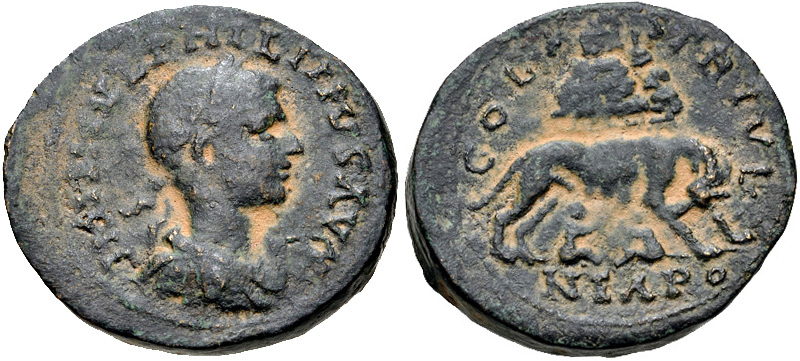
Neapolis, Philip II (AD 246-249). Wolf and twins; above. Mount Gerizim.
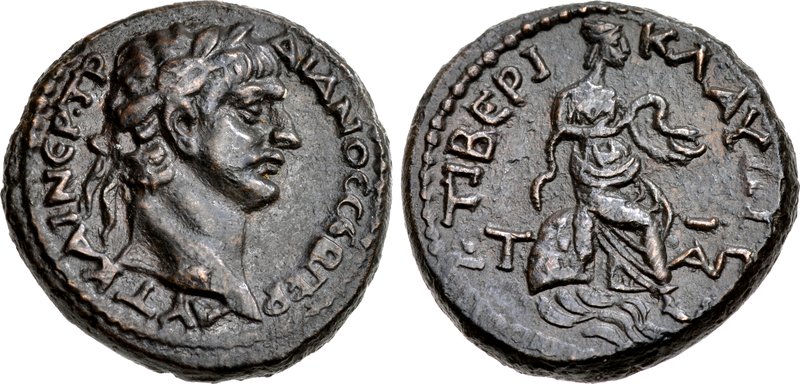
Tiberias, Trajan (AD 98-117), dated civic year 81 (AD 99-100). Hygeia seated on rock with water flowing below, feeding serpent from shallow bowl.
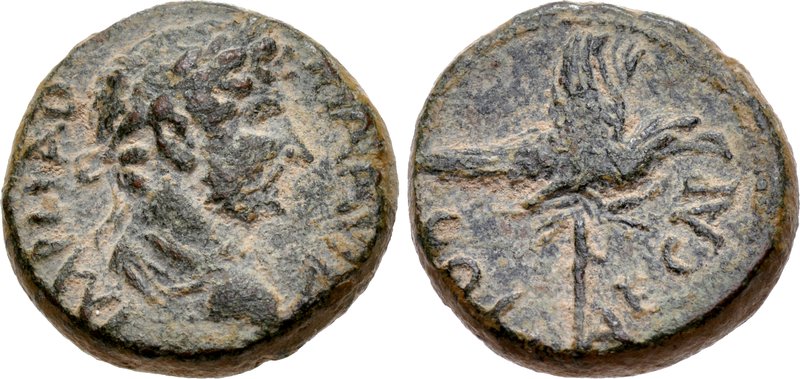
Aelia Capitolina (Jerusalem), Hadrian (AD 117-138). Legionary eagle. Hadrian was responsible for the re-foundation of Jerusalem as a colonia.
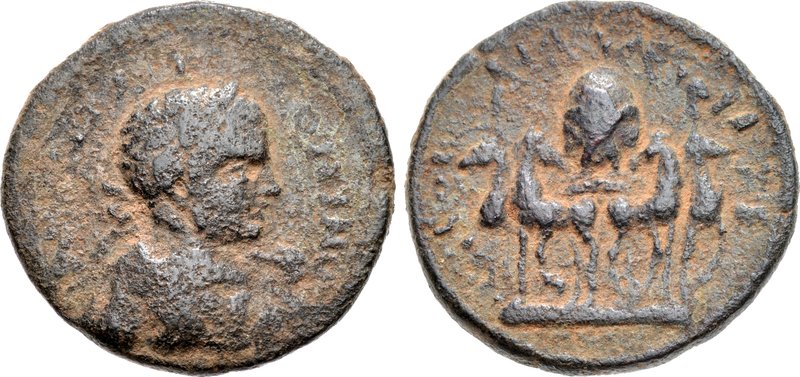
Aelia Capitolina, Elagabalus (AD 218-222). The stone of Elagabal in chariot.
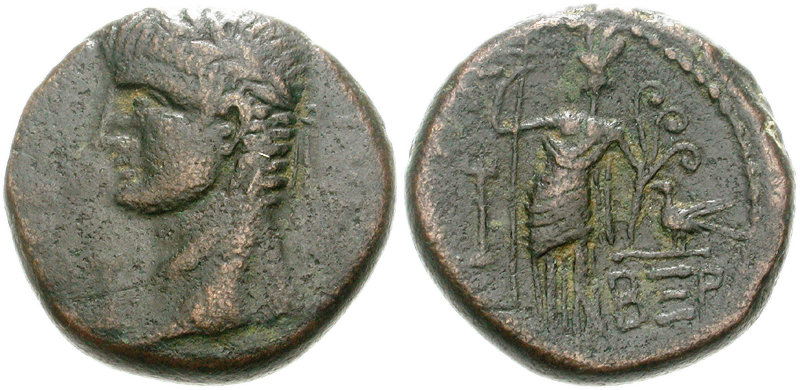
Ascalon, Nero (AD 54-68), dated civic year 162 (AD 58-59). Tyche of Ascalon, holding sceptre and aphlaston (ship’s stern decoration); dove to right.
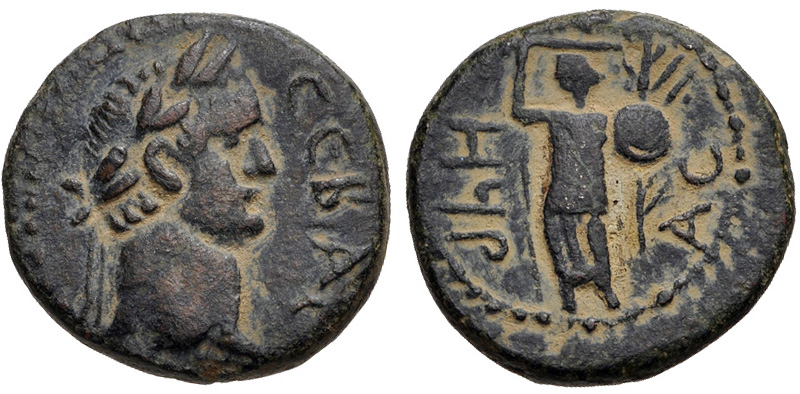
Ascalon, Domitian (AD 81-96), dated civic year 198 (AD 94-95). Male deity with sword and shield.
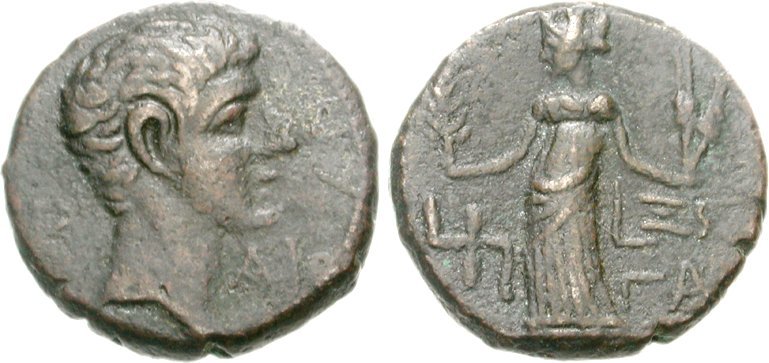
Gaza, Augustus, dated civic year 66 (AD 5-6). Tyche of Gaza holding palm and corn ears; symbol of the god Marnas in field.
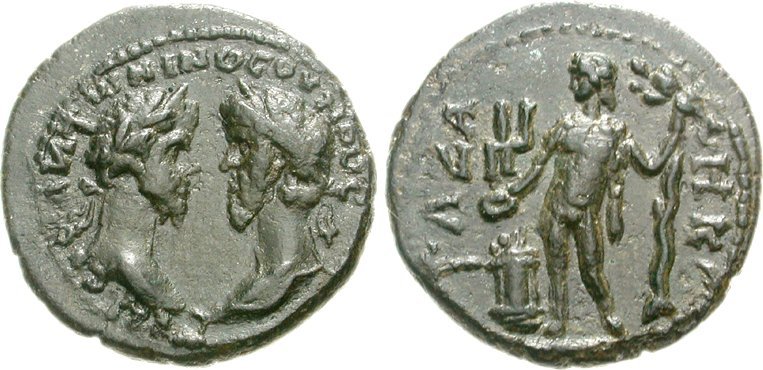
Gaza, Marcus Aurelius and Lucius Verus (AD 161-169), dated civic year 228 (AD 167-168). Apollo sacrificing over altar; symbol of the god Marnas in field.
Royal coinage
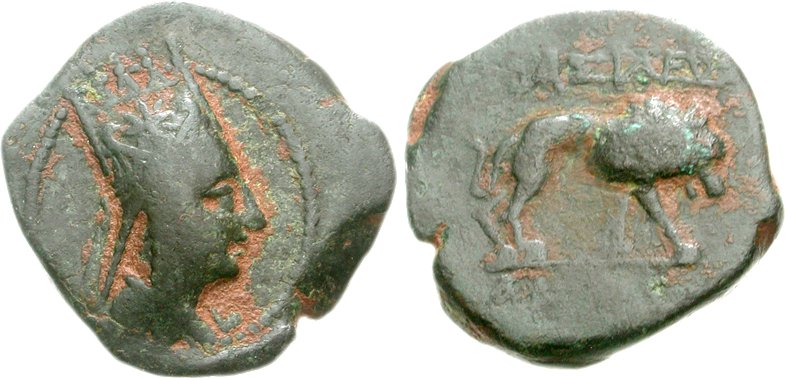
Commagene, Antiochus I (c. 69-34 BC). Lion.
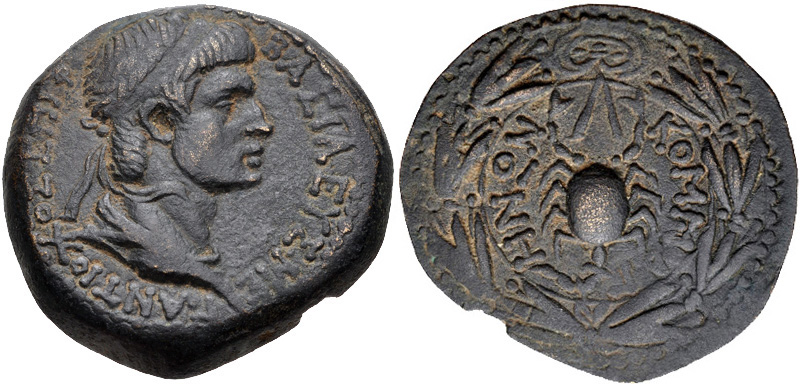
Commagene, Antiochus IV (AD 38-72). Scorpion in wreath.
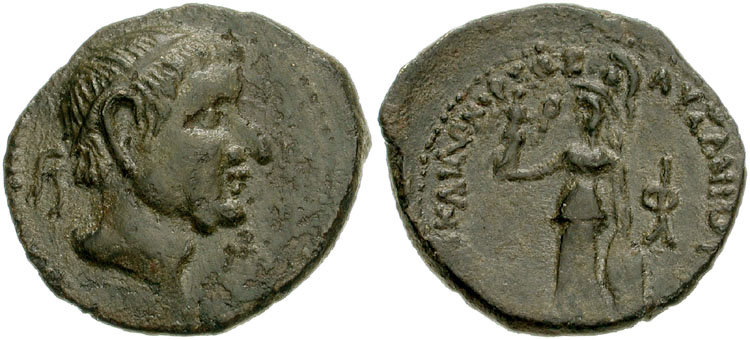
Chalcis, Lysanias. Diademed head with PTO monogram before (portrait of Lysanias' predecessor Ptolemy?) / Athena.
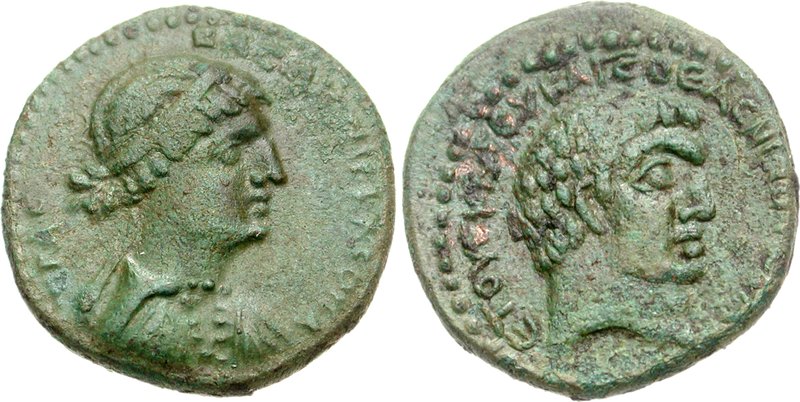
Chalcis, Cleopatra and Mark Antony, dated by Cleopatra’s 21st Egyptian regnal year and 6th regnal year in Chalcis, 32-31 BC.
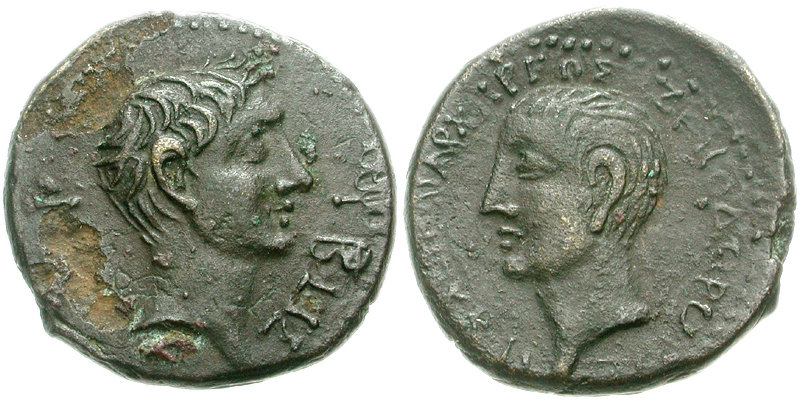
Chalcis, Octavian and Zenodorus, dated year 282 of the Seleucid era (32-31 BC). Zenodorus is named as tetrarch and high priest.
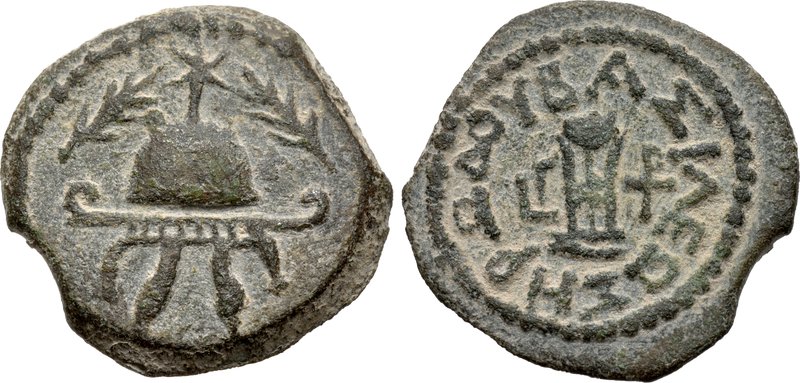
Herod the Great (40-4 BC), dated regnal year 3 (37-36 BC), minted in Samaria. Helmet / Tripod.
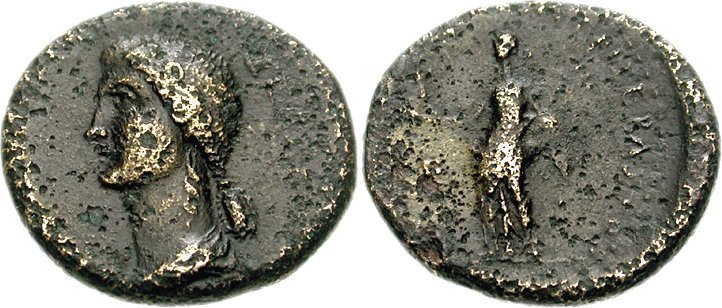
Agrippa I (AD 37-43). Paneas (Caesarea Philippi). Bust of Caesonia (wife of Caligula) / figure of Drusilla (daughter of Caligula). These coins bear the only certainly identifiable portraits of Caesonia.
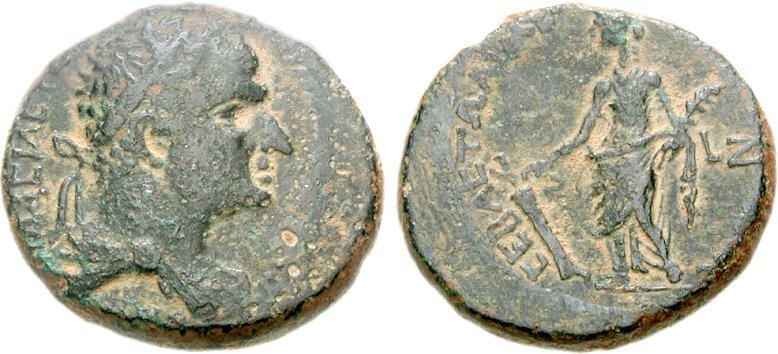
Agrippa I (AD 37-43). Caesarea, dated regnal year 7 (AD 42-43). Bust of Agrippa / Tyche of Caesarea.
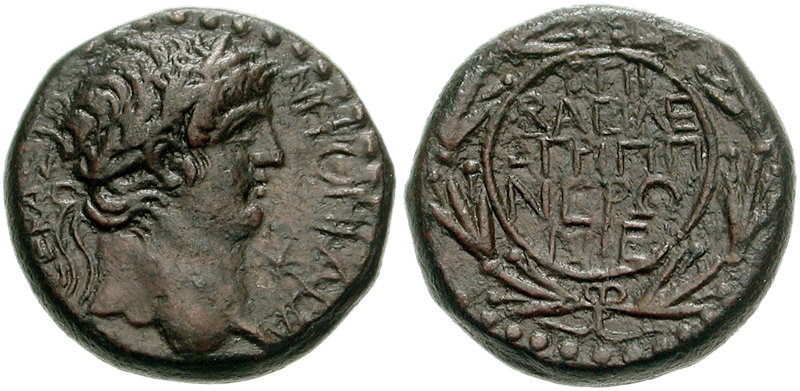
Agrippa II. Paneas (Caesarea Philippi), as Neronias. Nero’s portrait is on the obverse; the king’s name (and that of the city) is on the reverse.
